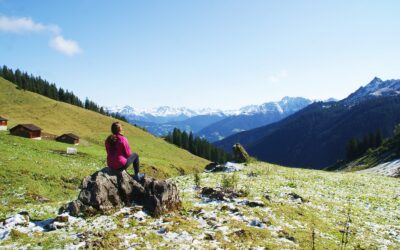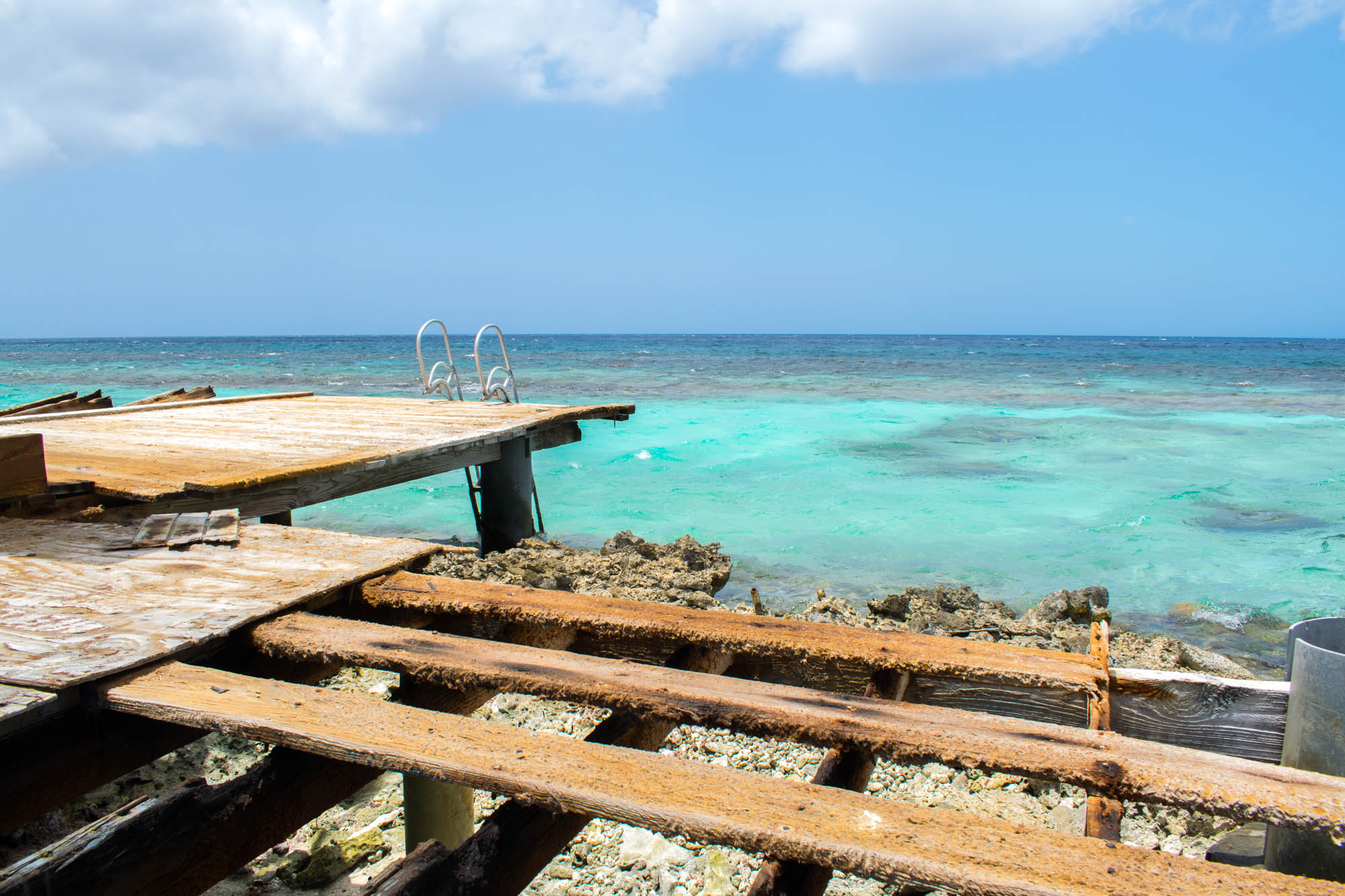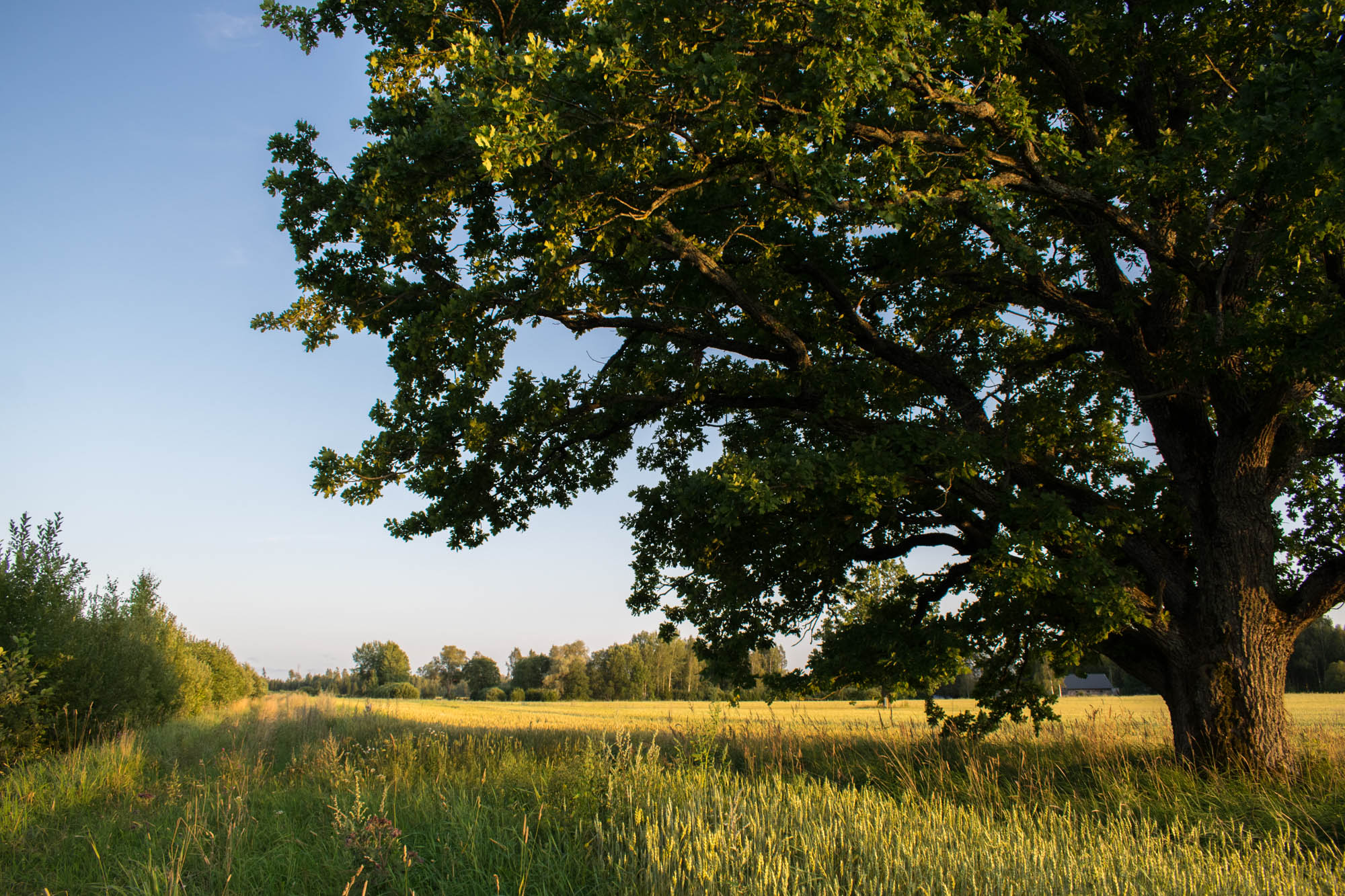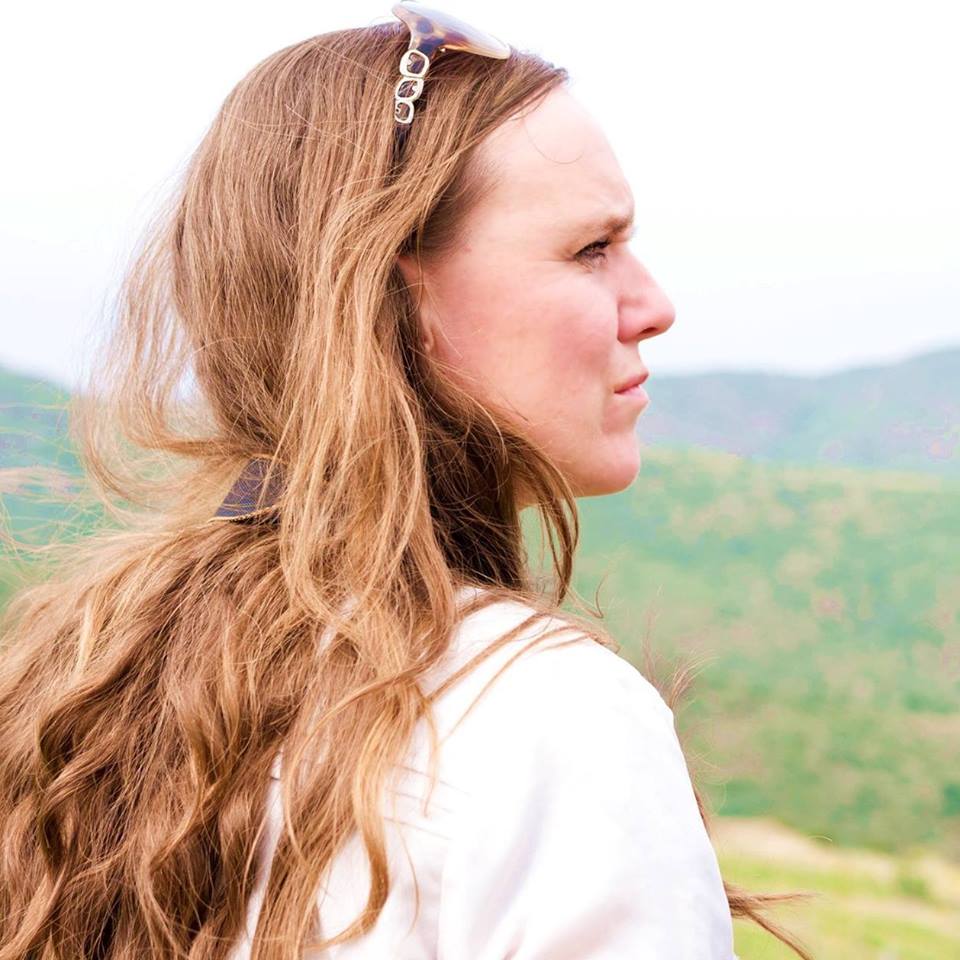Searching for Whales and the Northern Lights with Arctic Expedition
A cold wind is striking my face, but I can barely feel it.
I’m sat in a small rubber dinghy, surrounded by wild orcas and humpback whales on all sides. Above me, I can see eagles soaring and hundreds of seagulls excitedly prepare for their next meal. This is paradise to me.
The steep mountains create a dramatic backdrop for the fjord ahead of me, and the Arctic morning sky is tinted in a pale pink. I have just enough time to capture the perfect picture of an orca as it breaks the surface and reveals the massive white spots on its shiny back.
This magical early morning meeting with the local wildlife is one of many highlights on my tour of the hidden fjords of Tromsø with Arctic Expedition.
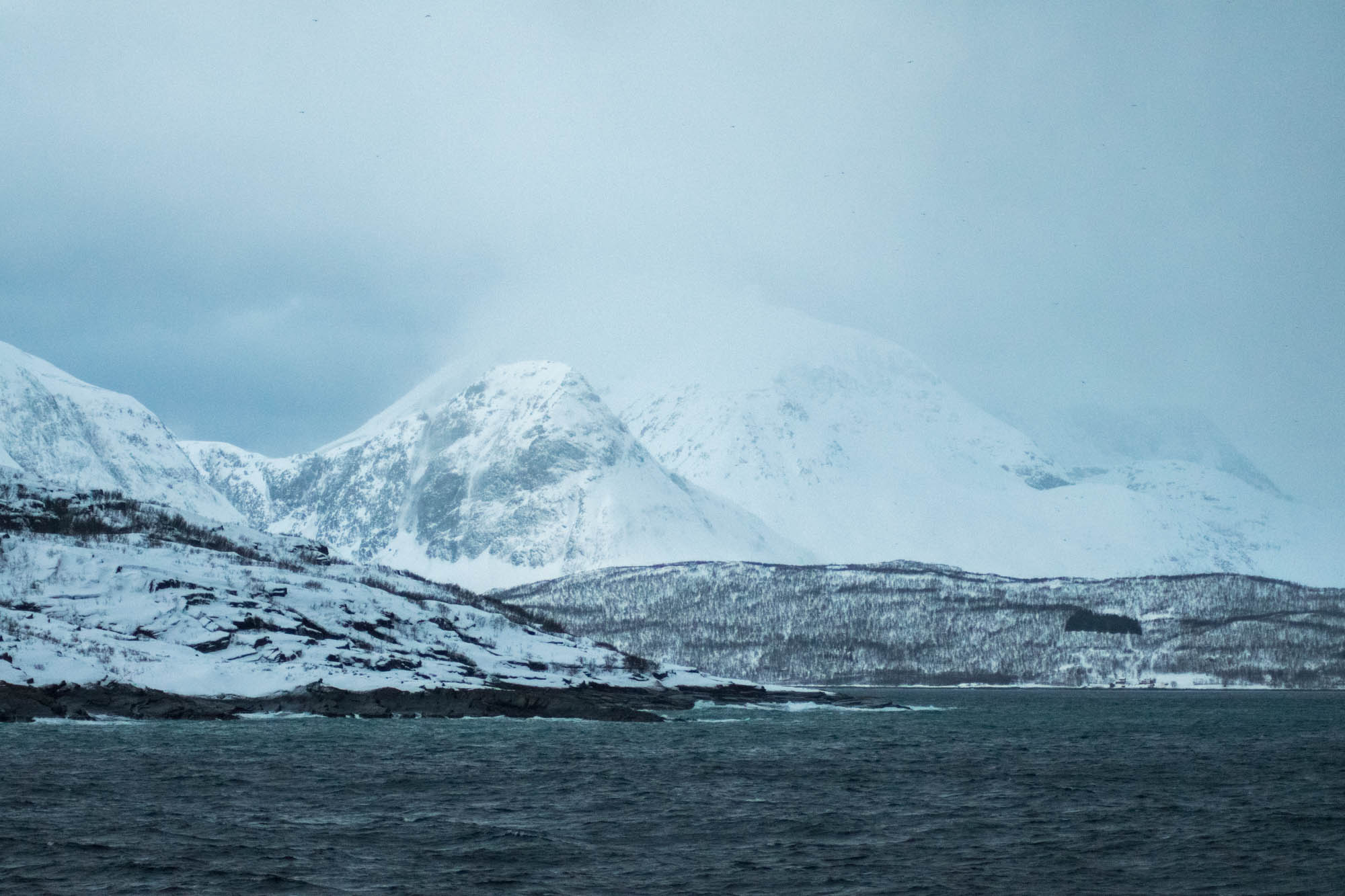
A 4-Day Arctic Expedition Onboard Quest
On the wildlife tours in the hidden fjords near Tromsø, Arctic Expedition use the ship Quest. Although it’s barely 50 metres long, the ship still contains an impressive 26 double cabins. Originally built in 1992, the ship went through a full renovation back in 2018. This means that the ship is now modern, comfortable and functional – and perfectly tailored to adventurous expeditions in the Arctic.
My tour both starts and ends in Tromsø, and during my four eventful days onboard we had the time to see both the local fjords and the sea outside of Tromsø. As the tour took place in January, I was travelling during the dark times. Also known as Polar Night, this occurs in the northernmost regions on Earth when the night lasts for a full 24 hours. During the summer months, however, the opposite phenomenon occurs and the region experiences Midnight Sun. Although January was steeped in darkness, we were still lucky enough to see a little bit of light peeking through between 10.00 and 14.00.
The winter darkness brings both limitations and advantages to tours like this. The activities that required light were carefully scheduled for the early mornings. The remaining time was used for transportation, lectures and – perhaps my favourite winter activity – chasing the Northern Lights. Every day contained a tightly packed schedule, carefully detailing when we were to meet for excursions, and when were supposed to eat. In addition to this, I also had plenty of spare time to enjoy the magnificent view and the nature around us, as we slowly made our way through the Arctic fjords and islands.
If you’re more of a laidback traveller, there’s also possible to enjoy some well-deserved downtime in your cabin.
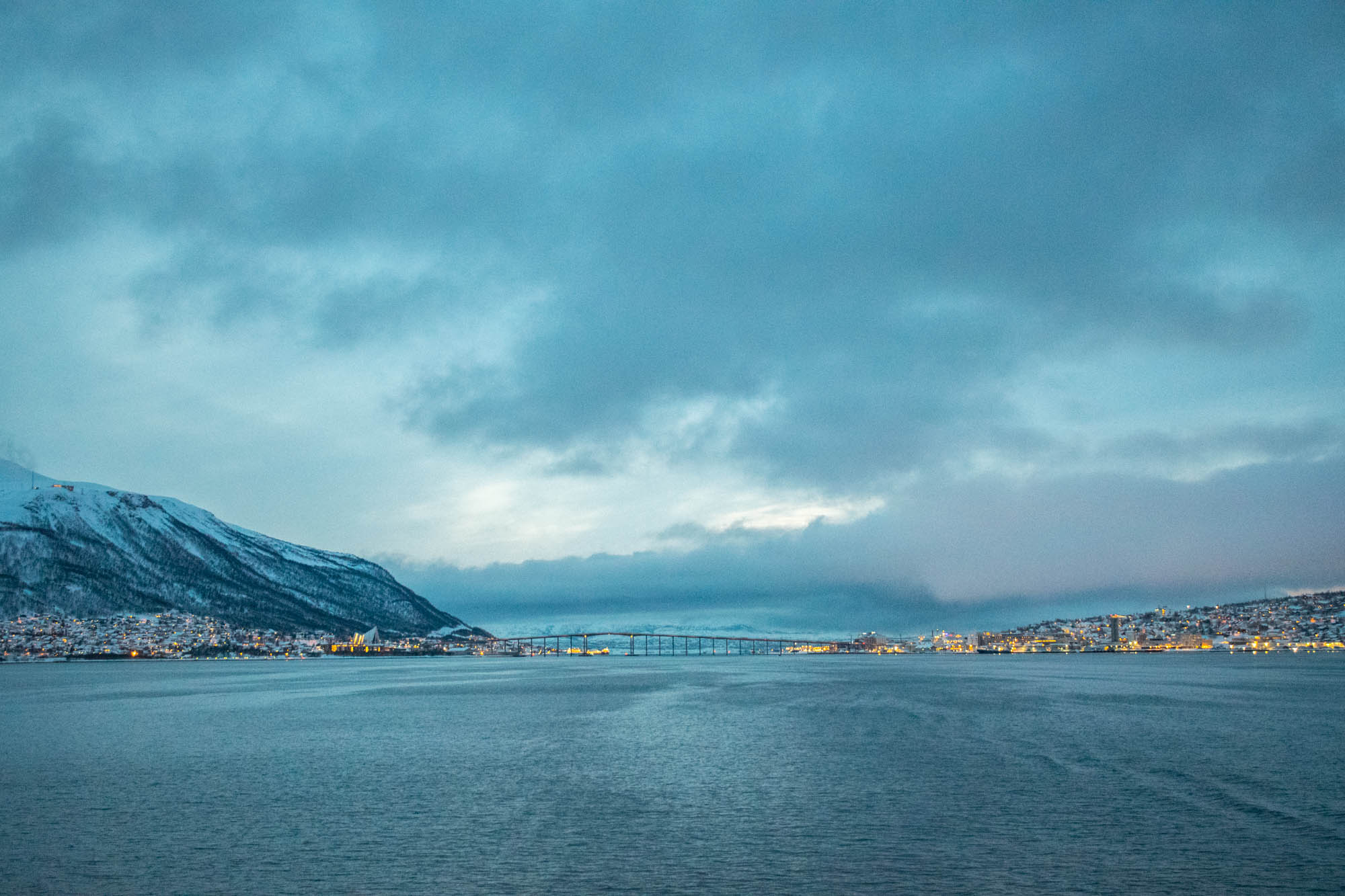
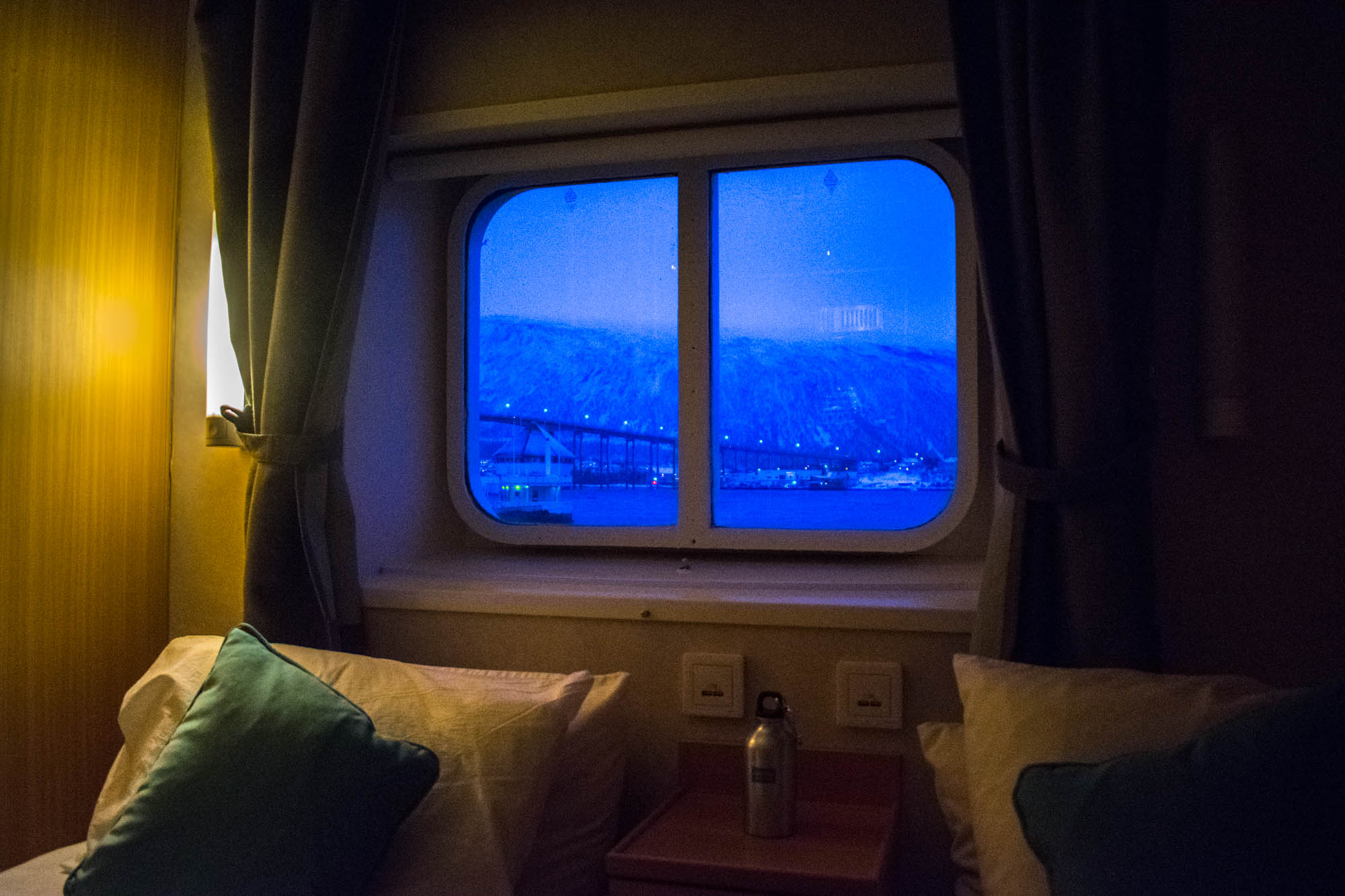
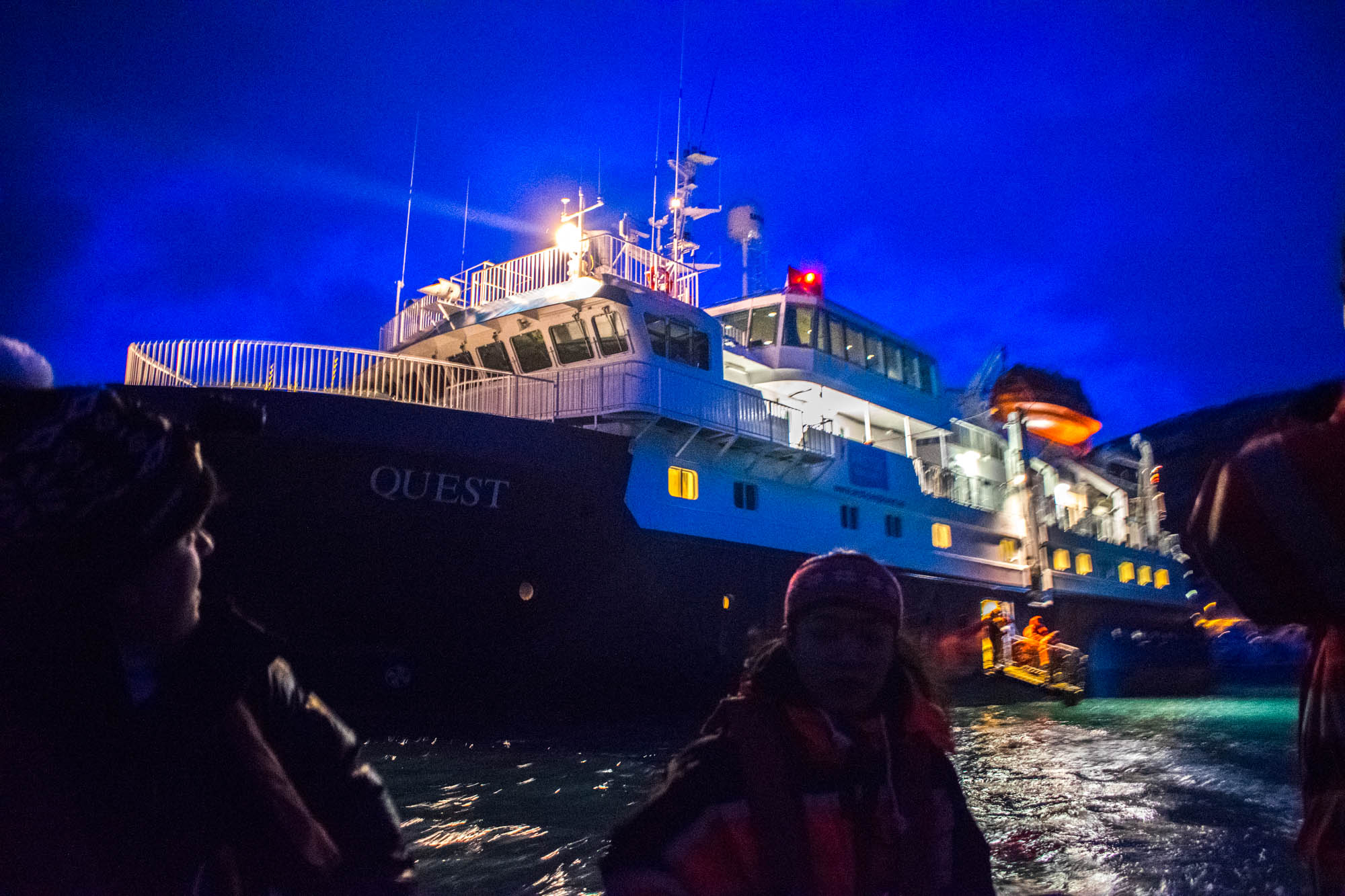
Unique Experiences and Valuable Lessons
Learning is key when you travel with Arctic Expedition. The very aim of the expedition is to discover and learn more about the different aspects of Arctic nature, culture, wildlife and history. Here, the journey is a goal in itself – and not just a means of transportation.
This type of tour brings a great degree of freedom to the expedition leaders that organise the program. Although the schedules are mostly set, the guides and crew will still use their local knowledge of wildlife and weather to make the most of the experiences planned. If the weather suddenly changes, the captain will quickly change course so that you can best benefit from the experience. This flexibility is something I really appreciate in a tour company, as it means that you will always get the most from your experiences. Flexibility is also a great advantage when it comes to the more unpredictable experiences, such as the Northern Lights or whale observations.
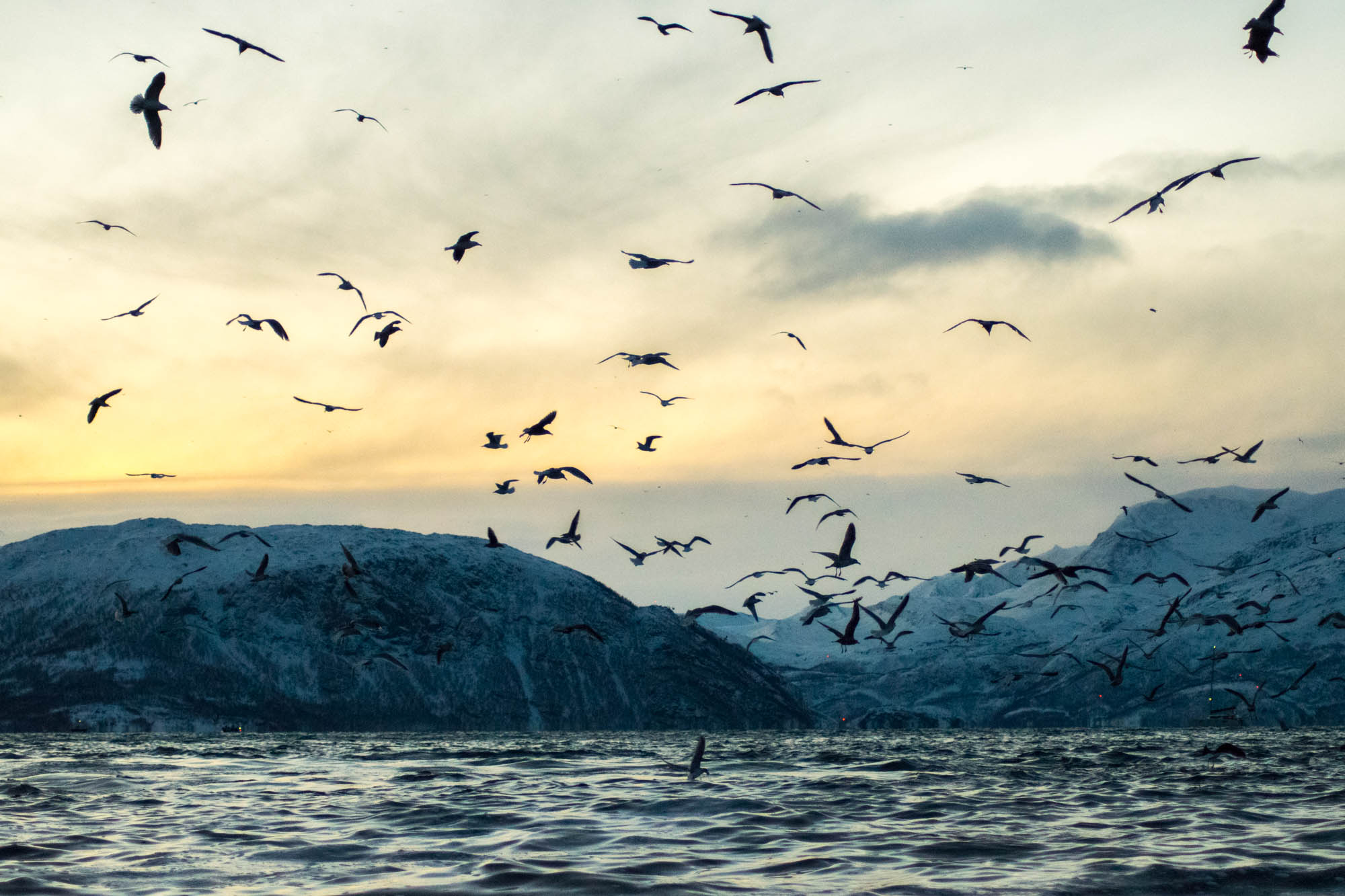
Discover the Arctic Wildlife
I have always wanted to see wild whales, so I was of course hoping that this would be possible during my journey.
To have the greatest chance of seeing them, we arrived at a quiet fjord early in the morning. Swept in darkness and cold, our ship could carefully turn off its engine and thereby minimize the movements in the water. As soon as a little light started breaking through, we put on our thermal suits and life vests, our gloves and hats, and made our way towards the middle of the fjord in little rubber dinghys. However, we were not the first ones there: Several local fishing boats were already there, carefully dropping their nets into the dark water.
And the sound of the nets made something happen deep down in the fjord.
When the Food Bell Tolls
The fishing nets made a swift ring when they hit the water. And, soon after, we could see some activity happening in the water below us. Suddenly, the whales started flocking around the boats!
For the whales, the sound of the fishing nets had alerted them to breakfast time. We could see orcas and humpback whales rush towards the nets, eager to get their piece of the standing buffet. The whales obviously knew what was waiting – fish galore!
The whales weren’t the only ones who knew that the boats meant great access to food. Around us, we could suddenly see hundreds of seagulls and a few hungry eagles circling around the boats. They too were eagerly waiting for breakfast on a cold winter morning.
Observe, Don’t Disturb
If you want to experience whales in their natural environment, it’s imperative that you always act correctly and that you respect the animals. You don’t want to cause them any stress or fear.
We only used small boats and we always remained on the outskirts of the area, careful not to let the whales feel as if we were chasing them around. Our guides knew the whales would be attracted to the fishing nets, so we simply turned off our engine and did our very best not to disturb them during their breakfast hour.
Some of the whales were unexpectedly curious, and some of them even swam over to check us out a few times. I felt incredibly privileged to photograph and film these animals in their natural environment – even though it’s probably one of the most challenging tasks I have ever had. It was impossible to predict when and where the whales would resurface, and with the Arctic cold and quite a few waves, we had to sit quietly in the boat. I desperately tried to keep the camera steady and hope that I was sat in the right place.
After a few hours, I was left with an incredible experience and hundreds of photos and video clips of my favourite animal – the orca. A wonderful day at sea? Absolutely!
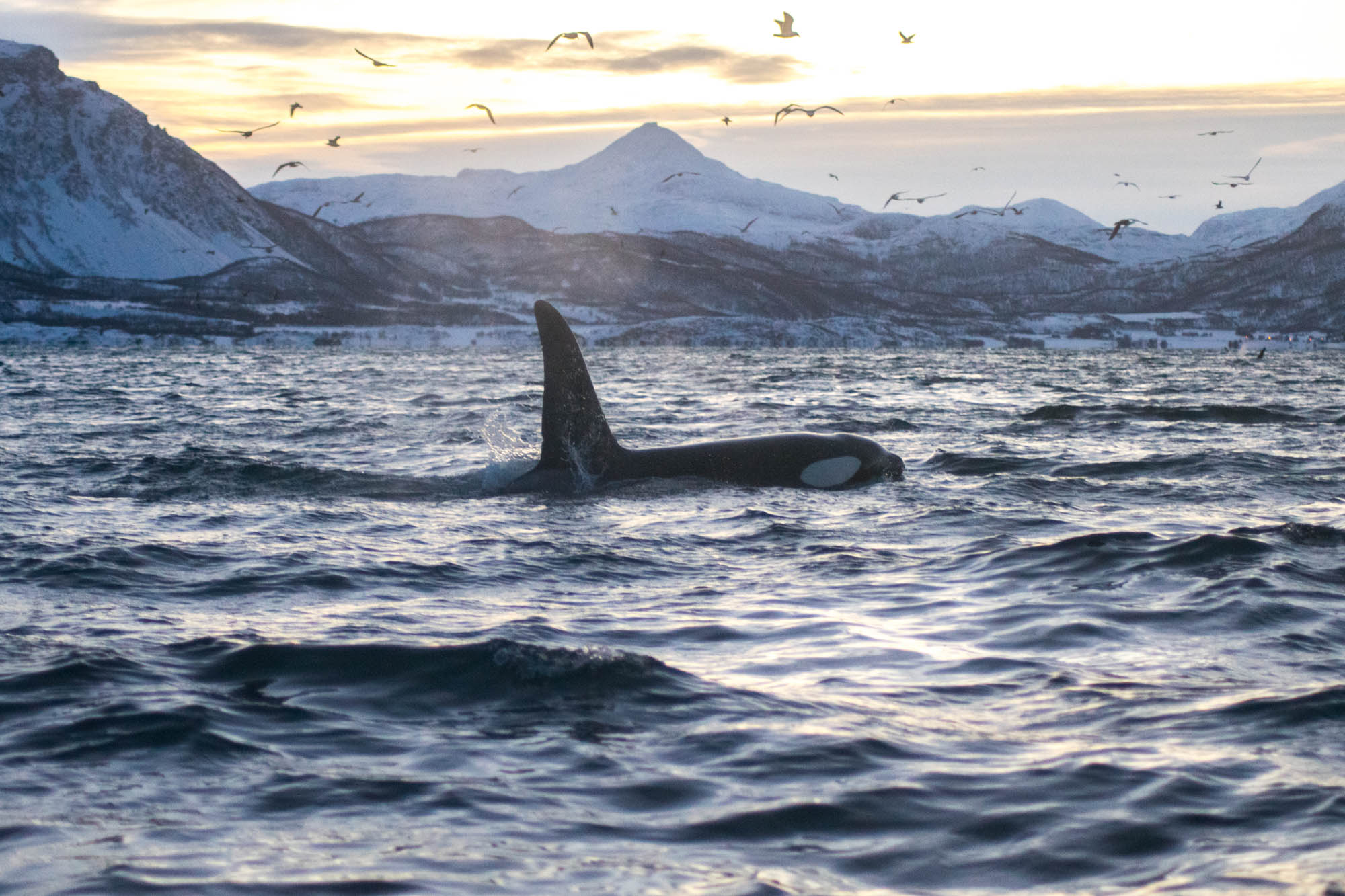
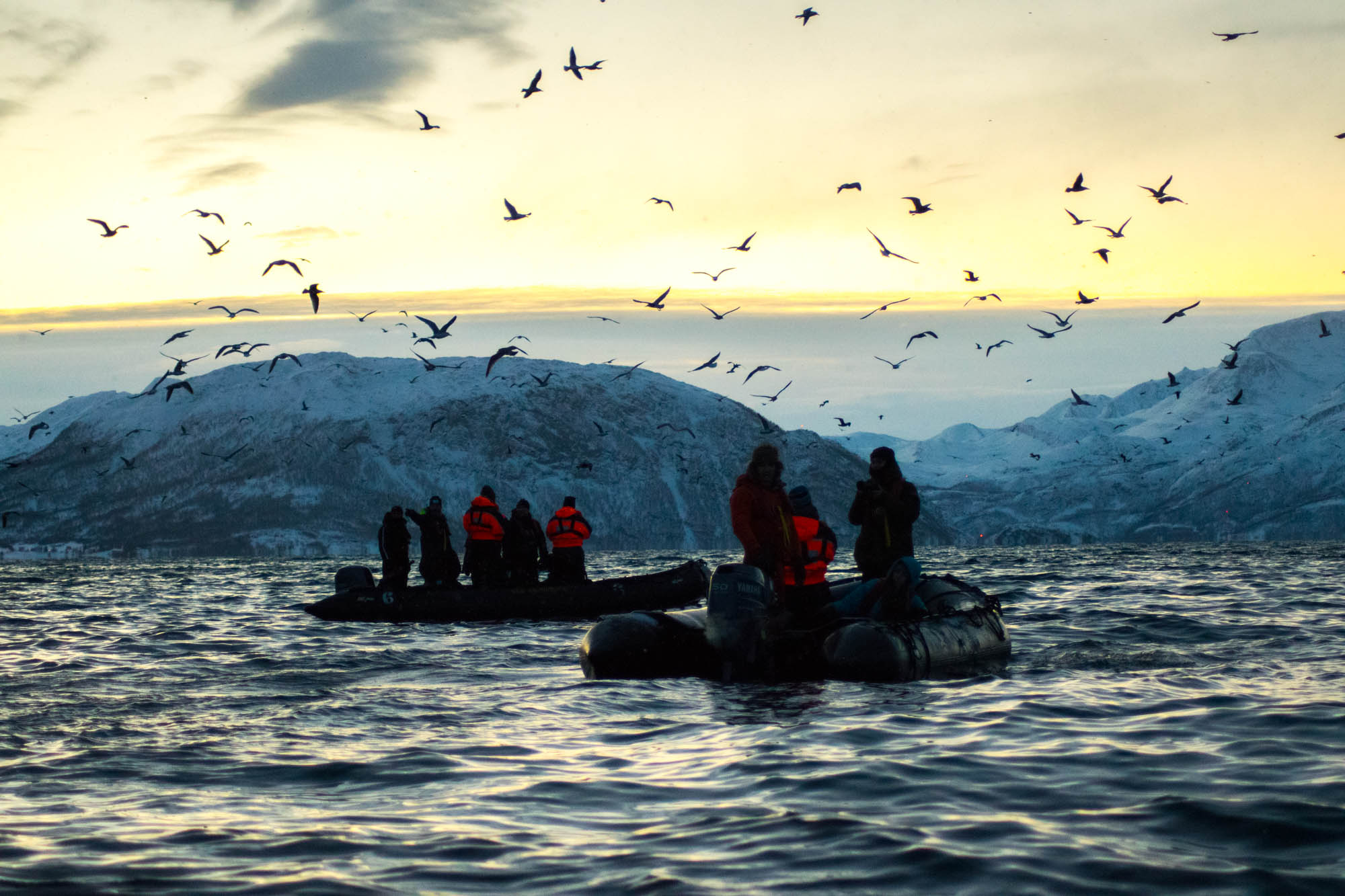
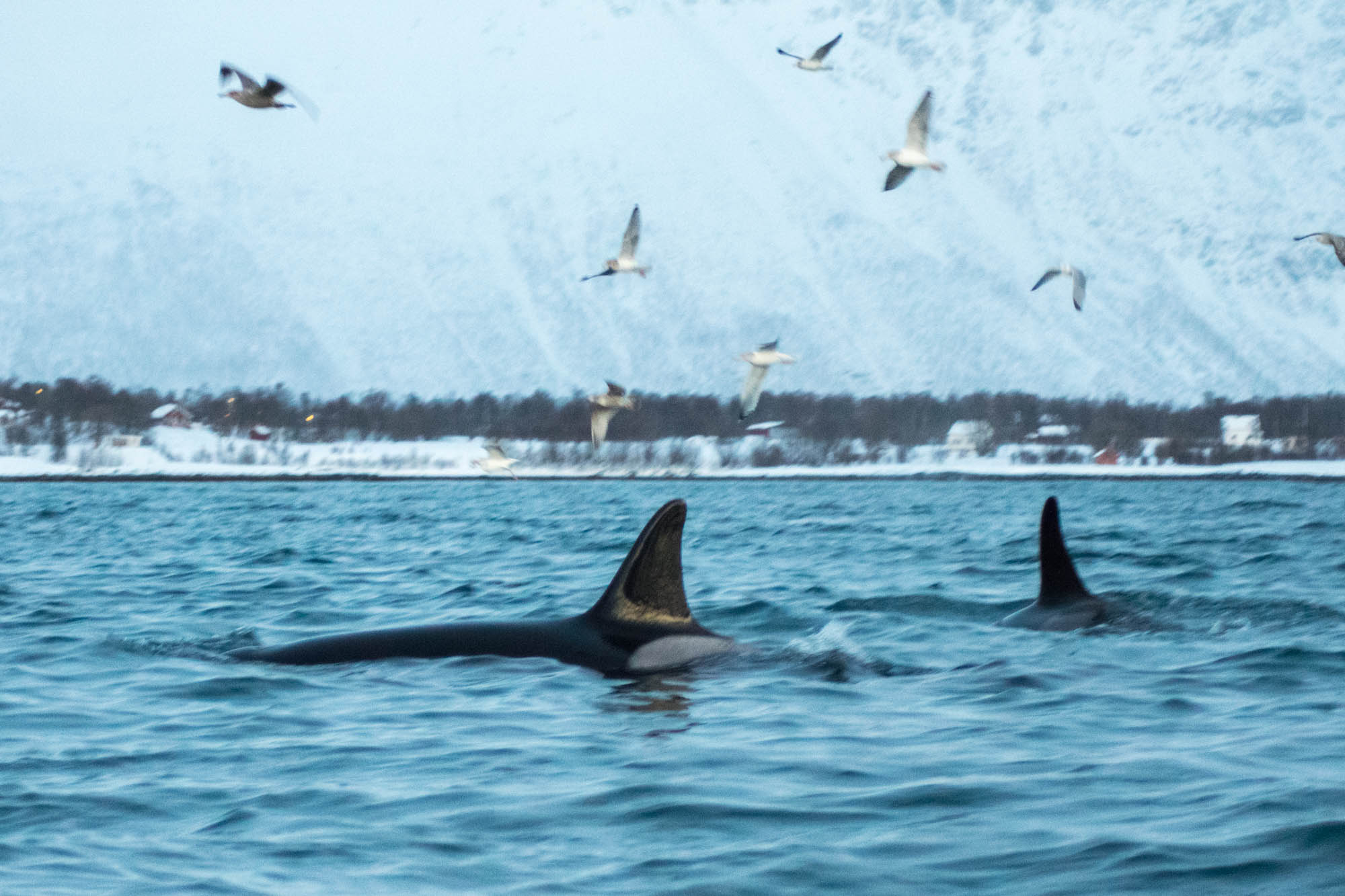
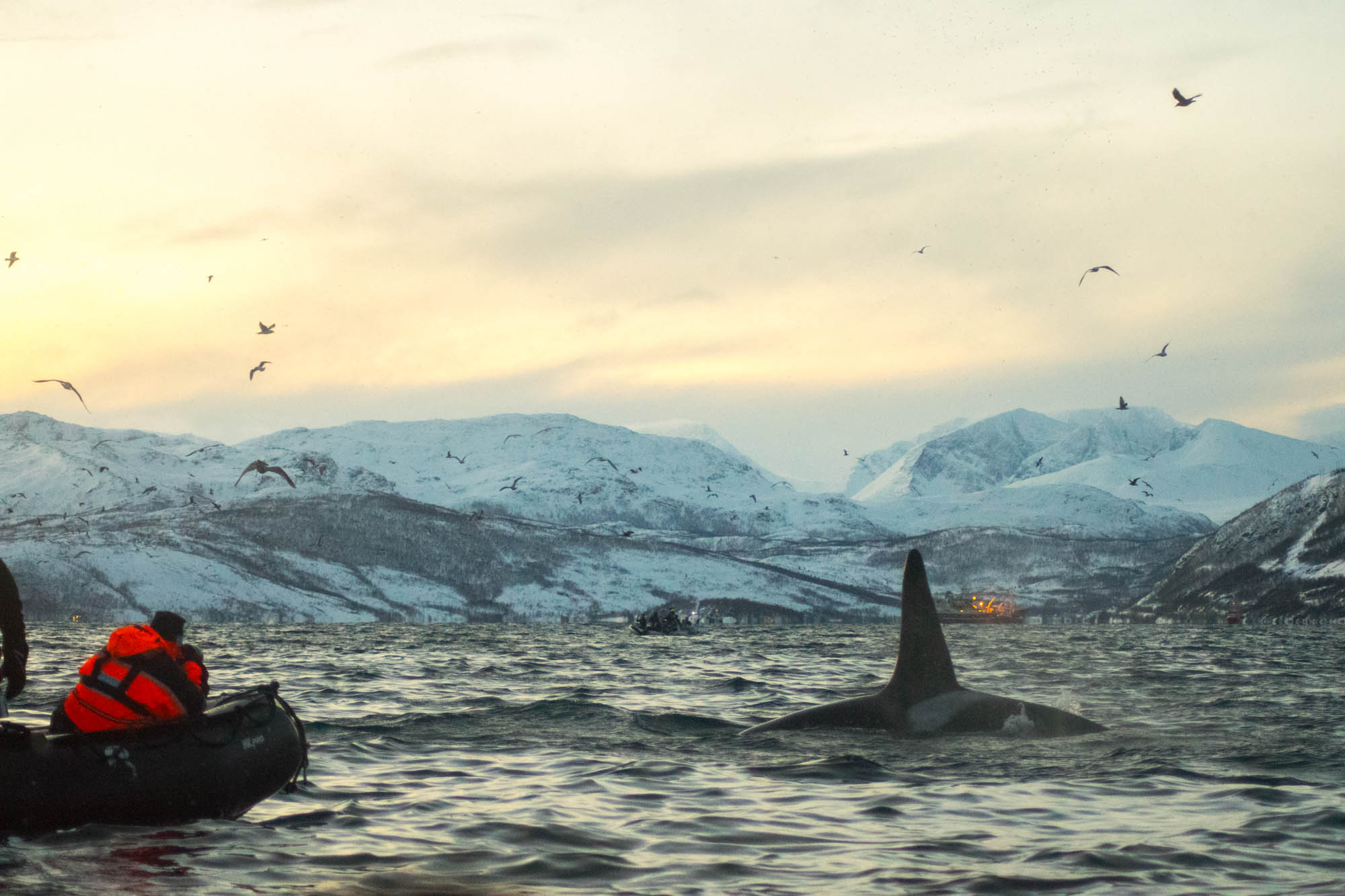
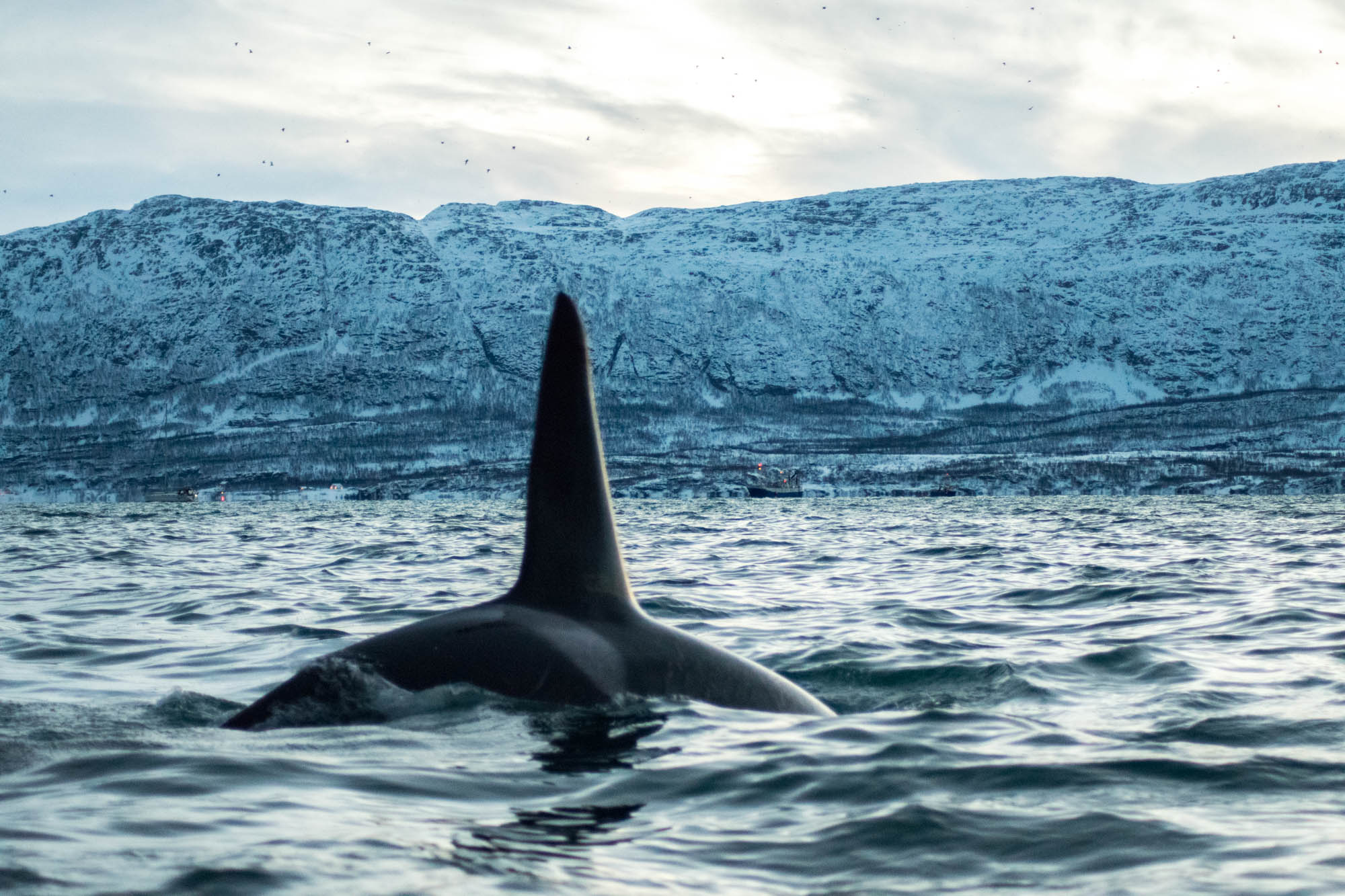
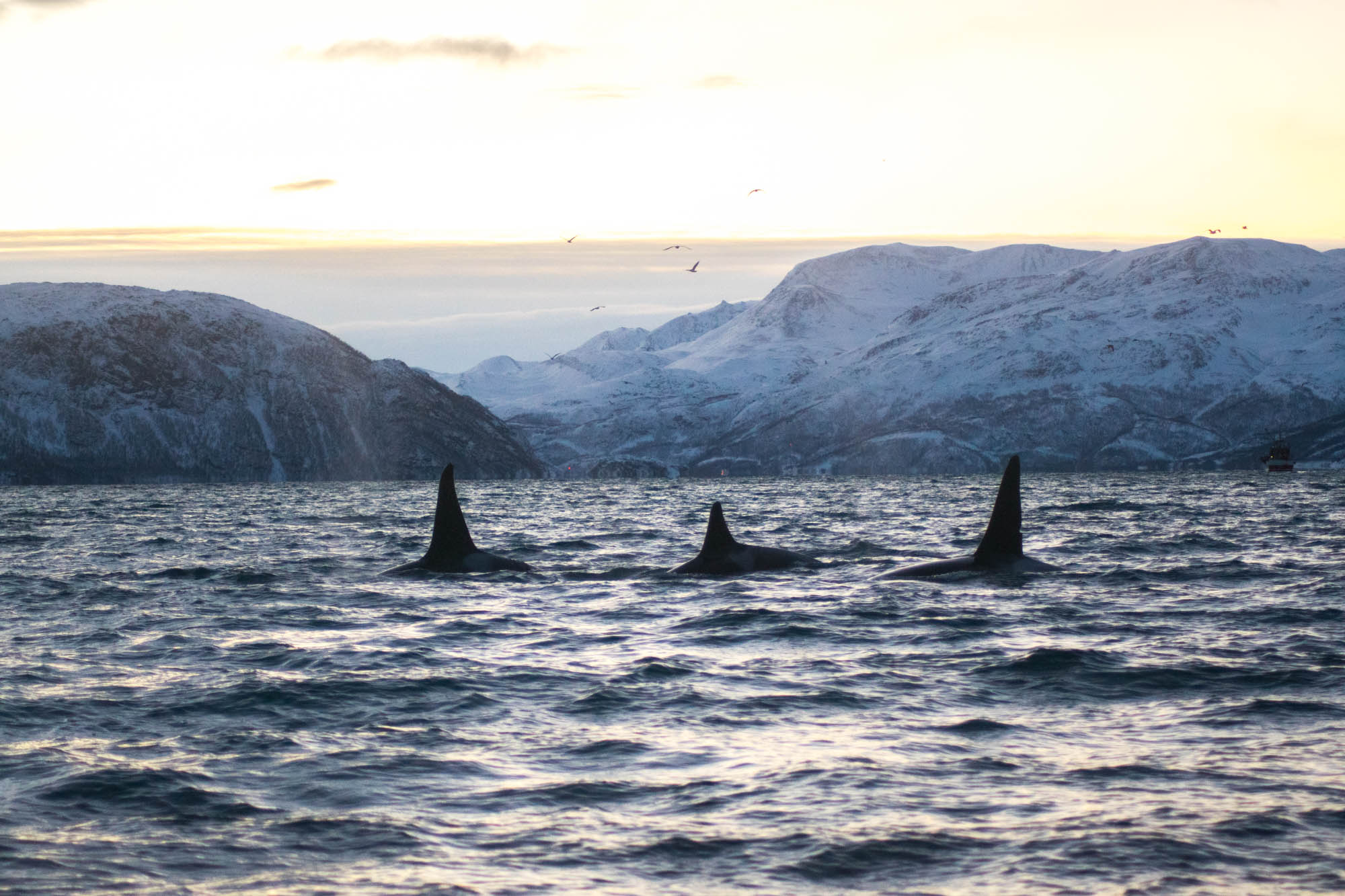
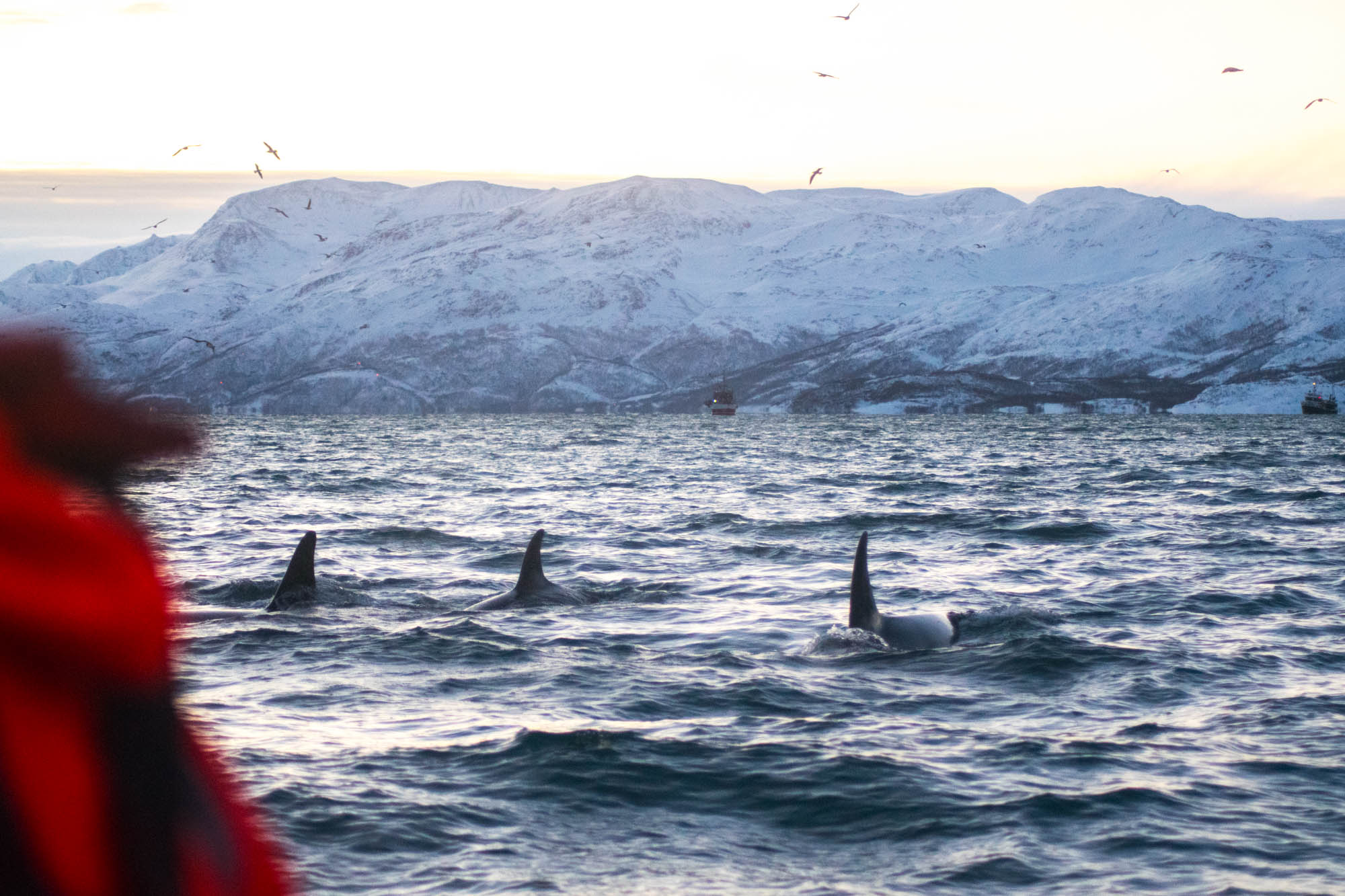
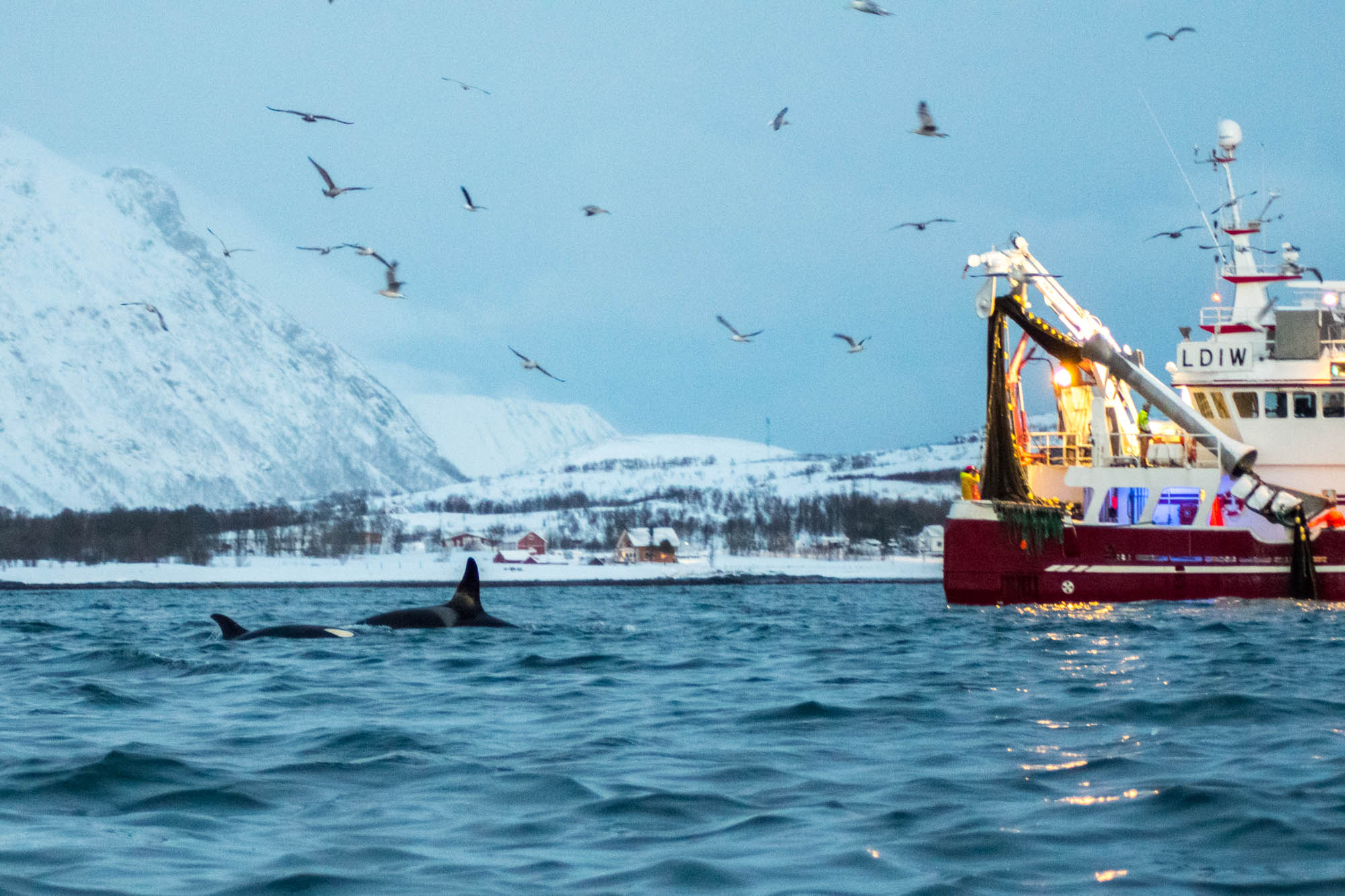
Facts About Orcas
I have always been fascinated with orcas. I find them to be incredibly majestic, and I have only grown to be more and more fascinated with them as I get older.
Orcas are said to be incredibly intelligent, which is shown in the way they communicate with each other and in how they coordinate when they are hunting for food. Between October and February, the orcas are often located in the fjords and waters nearby Tromsø. The orcas are the biggest species in the dolphin family, and they tend to grow to between 8 and 9 metres long. Depending on whether it’s a male or a female, their weight will vary between 5 and 8 tons. A proper heavyweight, in other words!
Surprisingly, the orcas are known for having a very long life span. Some females can reach the ripe age of 90, although the normal life span is between 30-50 years. At the moment, there are approximately 100,000 of them around the world. While most of them call Antarctica home, there are a few thousand of them that roam around the Norwegian Sea and the Barents Sea.
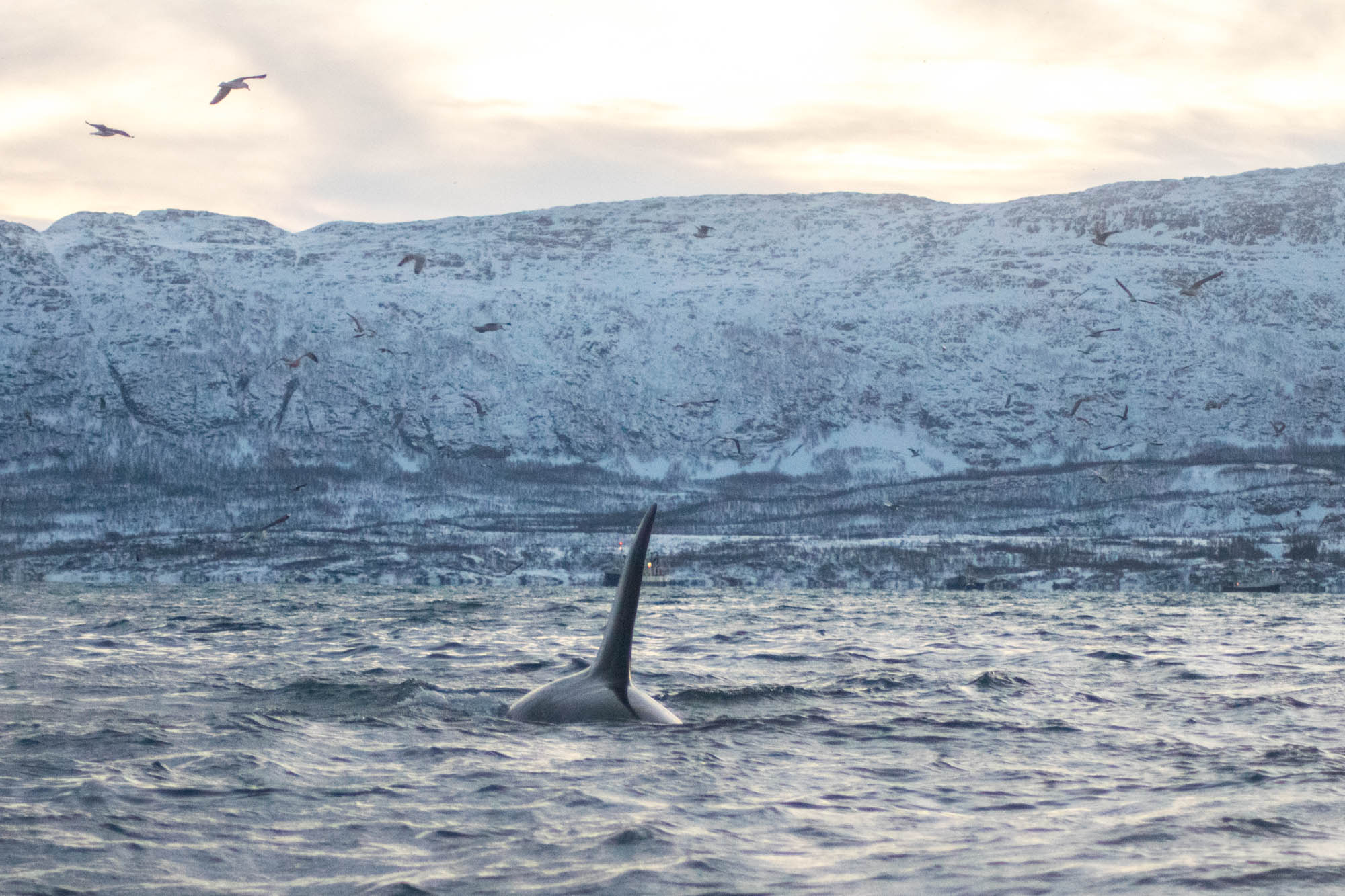
Facts About the Humpback Whale
The humpback whale is another local giant. Its Norwegian name (Knølhval) stems from the wart-like lumps on its body. In English, the name is derived from the hump on its back.
This species has a life span of up to 50 years. And when it comes to size, the females actually tend to be bigger than the males. The maximum length is 19 metres, and they can weigh up to 40 tons. The average, however, tends to be around 12-14 metres long and between 25-30 tons.
The humpback is a very playful animal, and it can often be seen literally jumping out of the water – often with its entire body. I think we can all imagine the extraordinary sight of a 30 tons whale jumping out of the water and landing with a massive splash! Although I didn’t get to see this extraordinary sight during my trip to Tromsø, I still got to enjoy the sight of their heads, bodies and tails before they once again disappeared down into the deep. A few of them even came close to our boat!
Today, there are an estimated 35,000 humpback whales around the world: Approximately 12,000 of these are here in the North Atlantic.
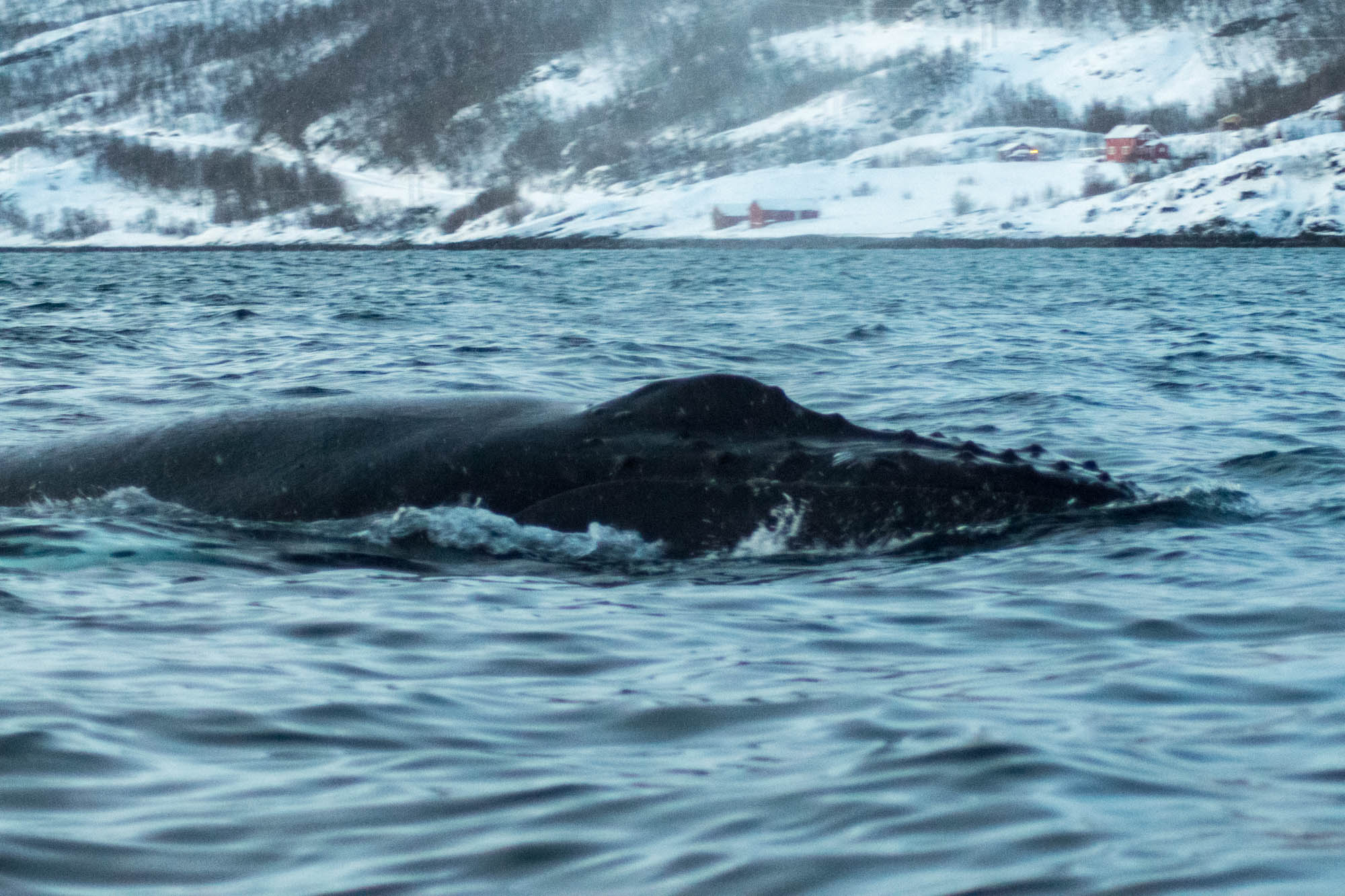
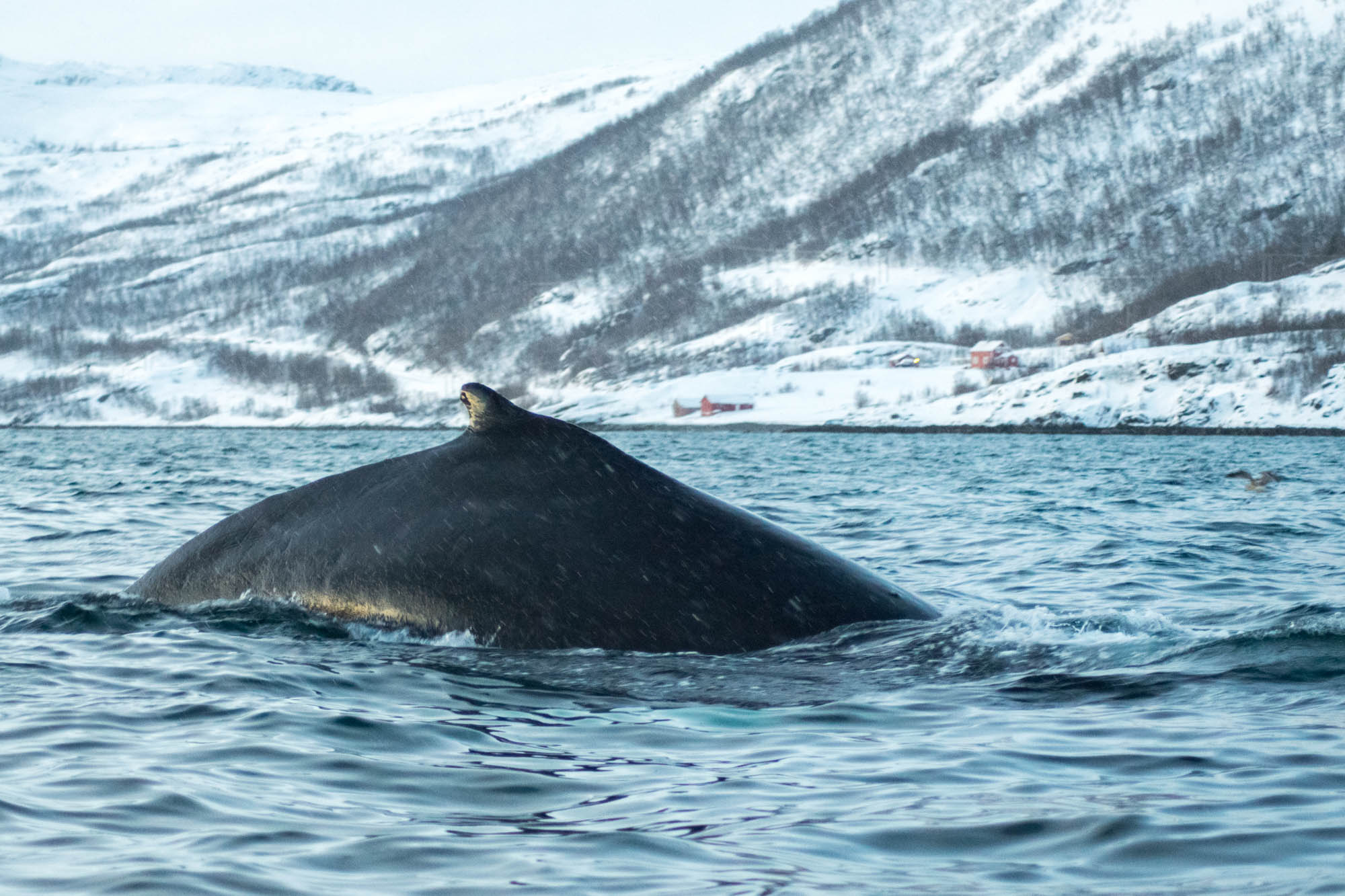
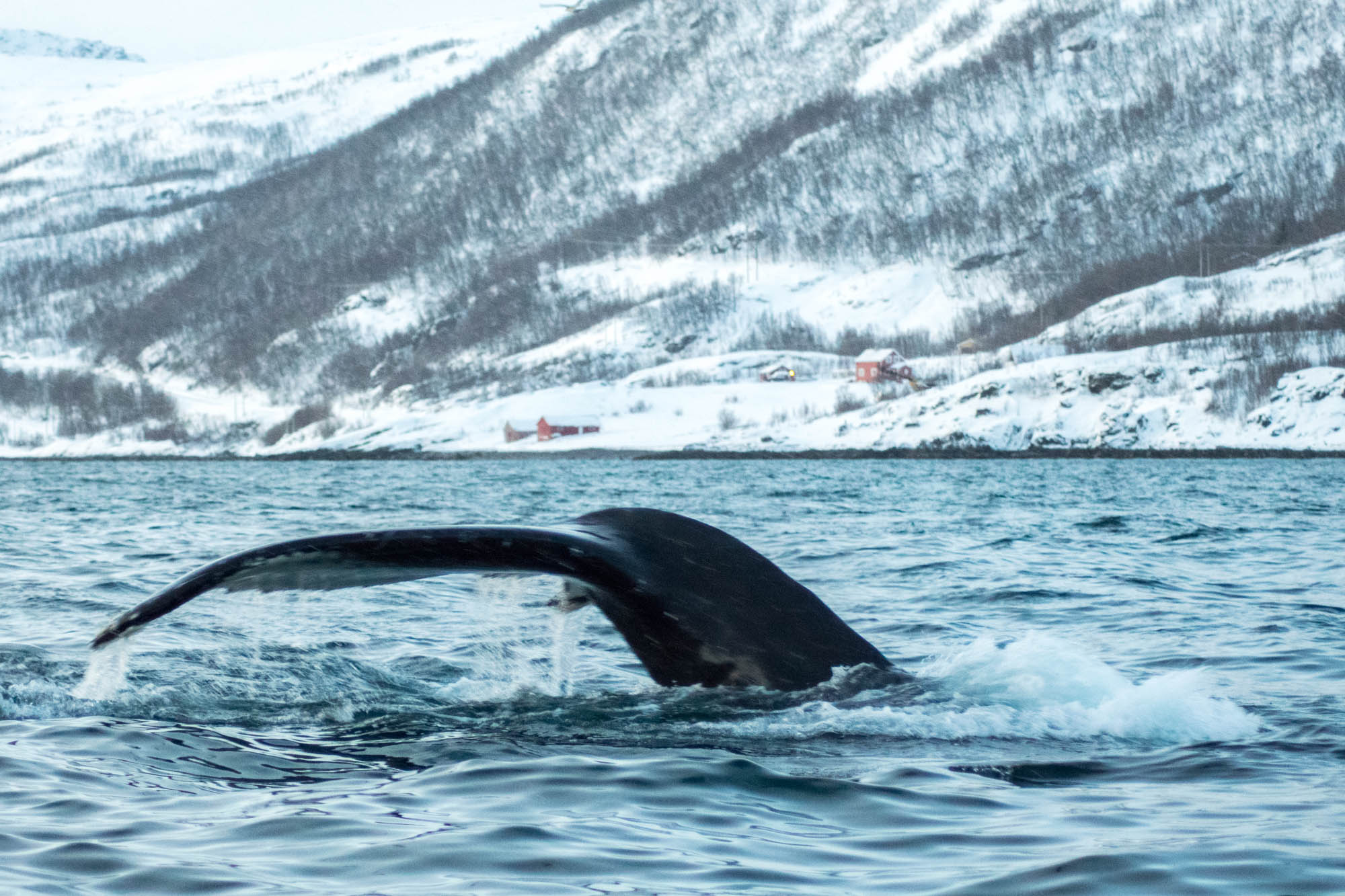
Chasing the Northern Lights
Although you can predict where whales are most likely to show up, Arctic Expedition can of course not guarantee that you will get as close to these wild animals as we did. The same goes for the Northern Lights. Despite Tromsø being the ideal area for spotting it, there’s no guarantee that you will be lucky enough to catch a glimpse of them.
What are the Northern Lights?
The Northern Lights, also referred to as Polar Lights and by its scientific name Aurora Polaris, is a natural light display that can happen around the South Pole and the North Pole. The southern one is known as Aurora Australis, while the northern is Aurora Borealis. In order not to confuse anyone, I will stick to the term ”Northern Lights” throughout this article.
But what exactly is it? As a matter of fact, these displays are the results of disturbances in the magnetosphere caused by solar winds. These disturbances alter the trajectory of charged particles. Once these particles collide with gases in our atmosphere, they emit the stunning light we know as the Northern Lights (or the southern one, depending on your location).
By tracking solar winds, experts can predict where it’s most likely to occur next. However, there are a few places that are more likely than others: The Northern Lights are displayed in a sort of oval around the pole, and these ovals are located at different places during day and night. And, during the winter nights, these ovals are located over Northern Norway – thereby making Tromsø the ideal destination for anyone looking to chase the Northern Lights.
The phenomenon displays various colours depending on how far up in the atmosphere the particles collide. The most typical colour is green, but it can also appear as white, blue or purple.
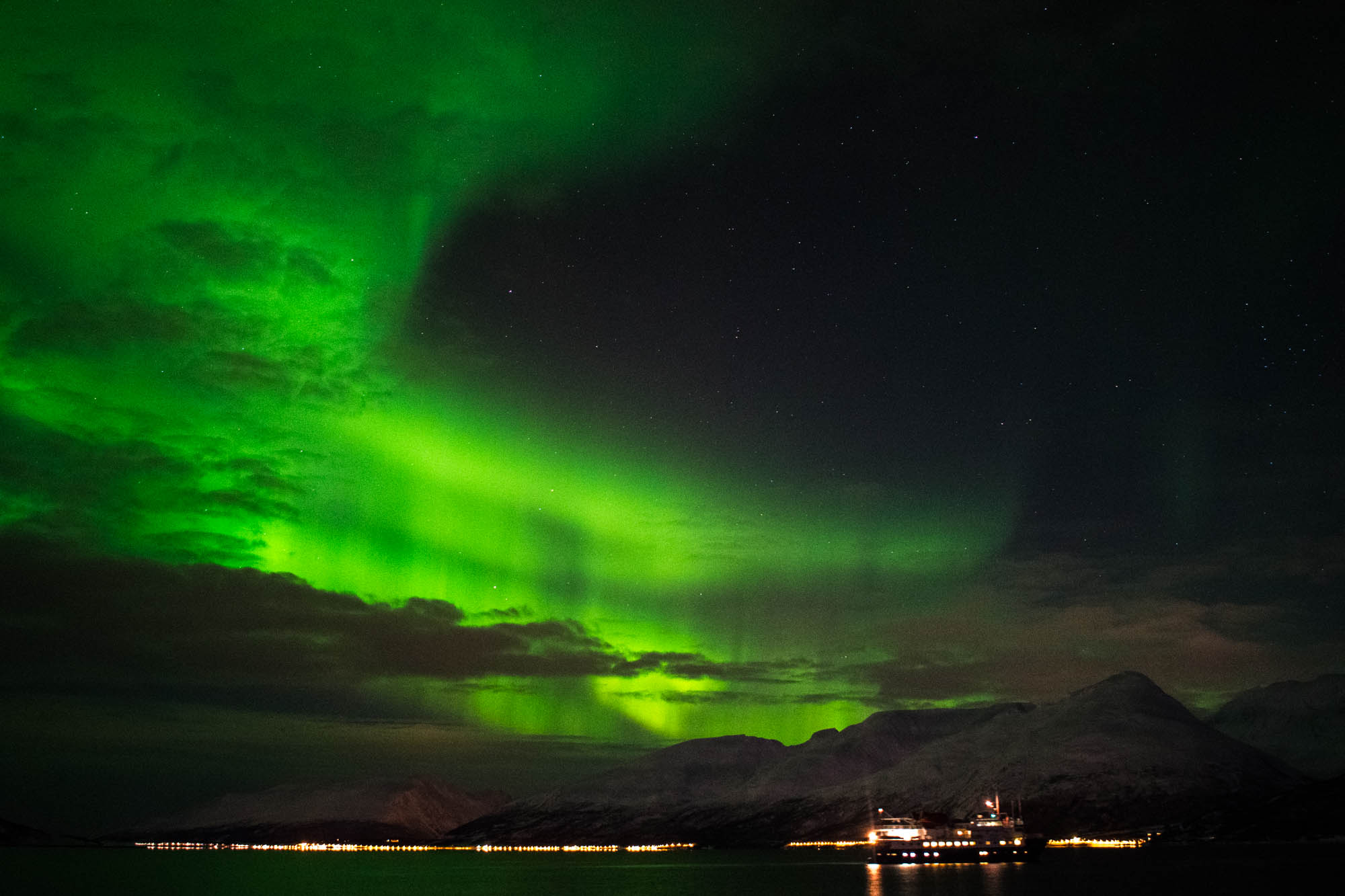
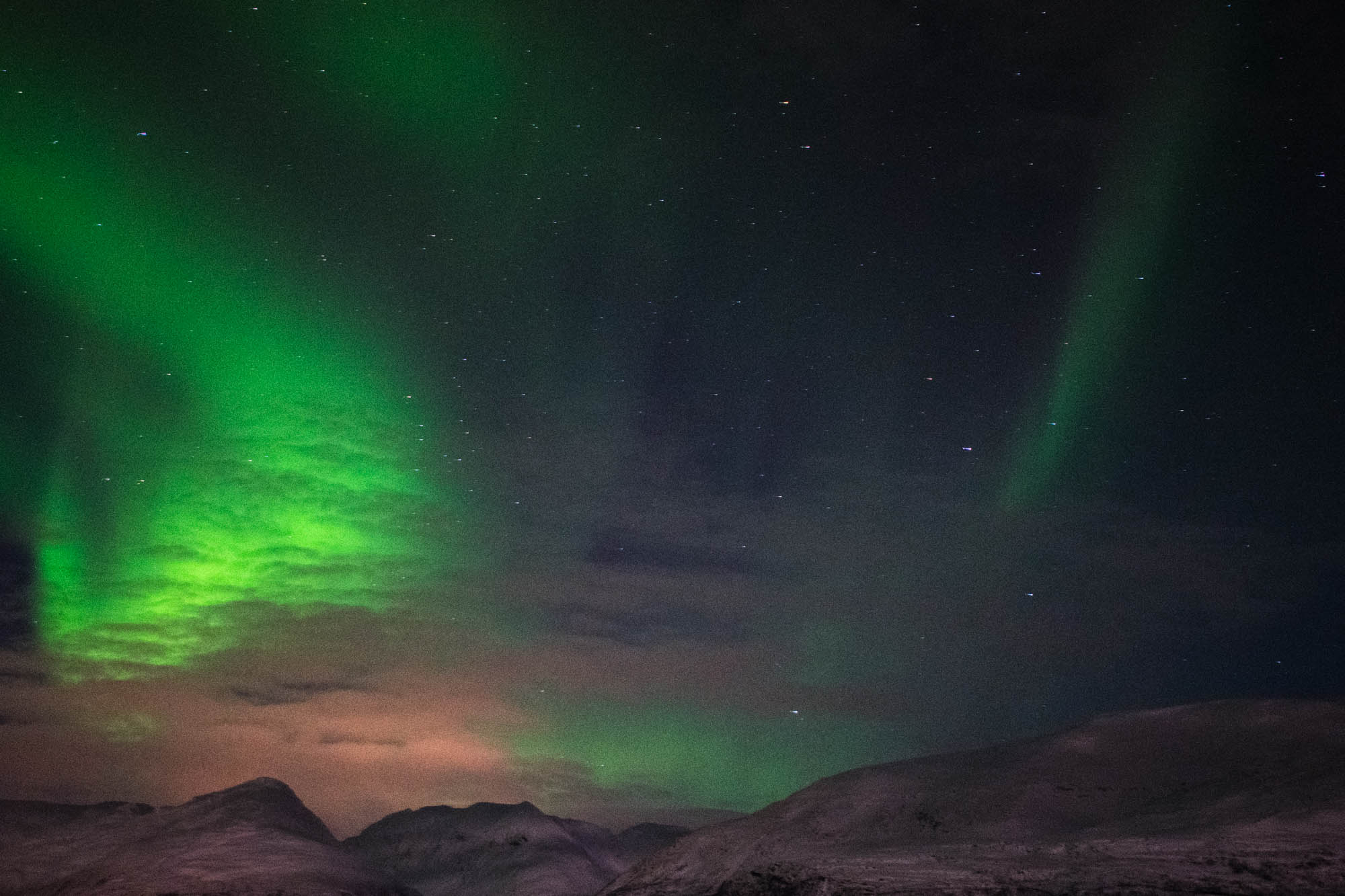
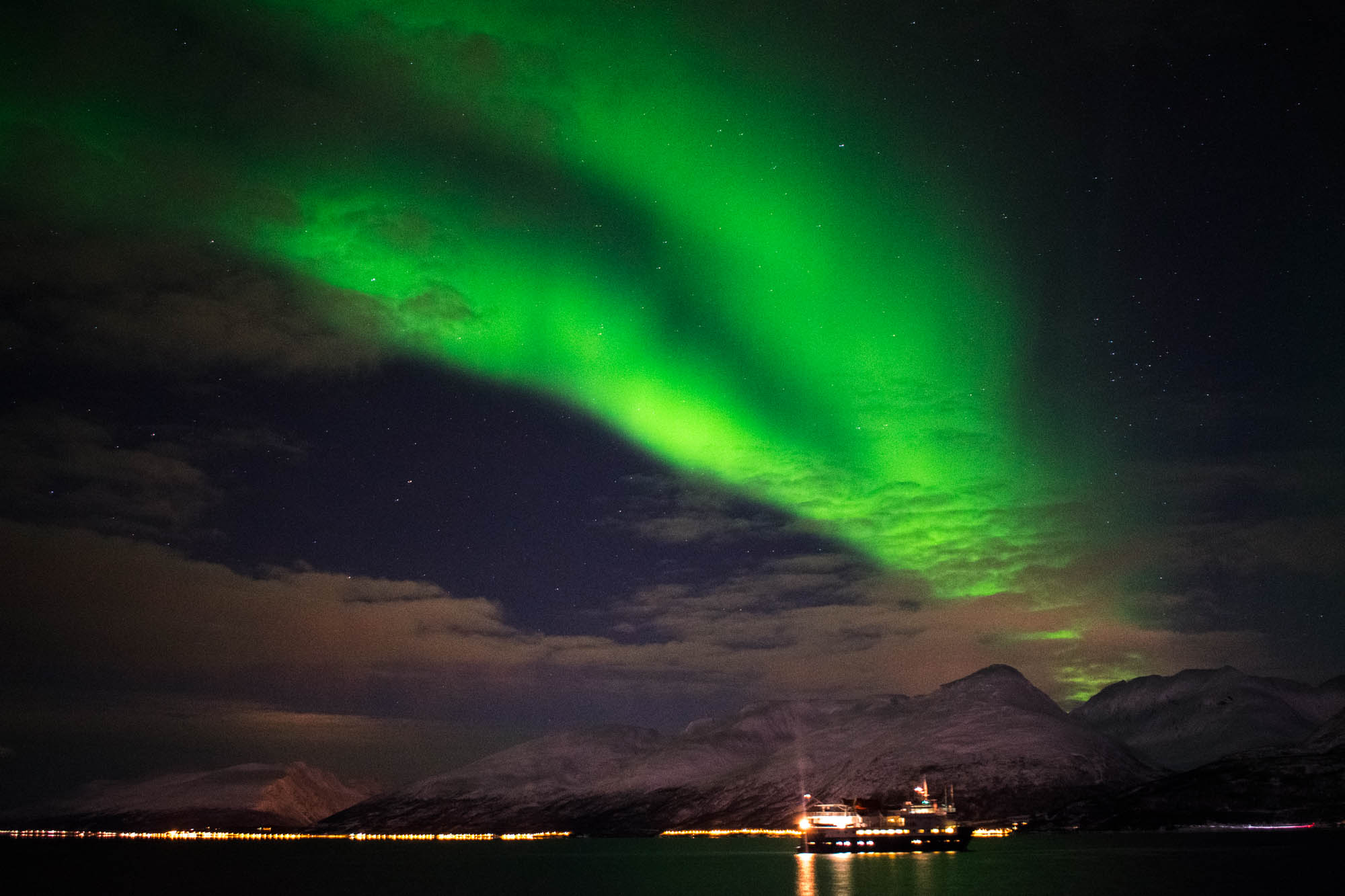
Northern Lights Forecast and Alarms
In winter, the Northern Light oval is often located right over Tromsø and the nearby areas. Although the lights can be unpredictable, Tromsø is a great starting point for anyone looking to see the Northern Lights.
Chasing the Northern Lights is an exciting experience in itself, and it was one of the key goals during my winter expedition with Arctic Expedition. The tour leaders onboard Quest kept a close eye on the weather forecast – and they all used mobile apps that provided details on where the display was most likely to be seen next. But even with modern technology, you still have to spend some time observing the night sky. Both the crew and the expedition team were constantly checking the forecast, and alerting us if they happened to see it. The ship even offered a special Northern Lights Alarm in the middle of the night for those of us who wanted it.
I volunteered for one of these alarms, and I was woken up once during my trip. I wrapped up in warm layers and wore my thermal suit over my pyjamas, before I made my way to the observation deck. Here, I got to see the magical light play around on the dark sky above me. It was an absolutely magnificient experience.
I also had another opportunity to see the Northern Lights during my trip. This time, it was during a late night expedition on the mainland. Luckily, I had my camera with me and had the chance to photograph it.
For those wanting to learn more about this phenomenon, I recommend attending some of the lectures offered by Arctic Expeditions. My favourite lecture focused on the Northern Lights and how it impacted local folklore throughout history. This knowledge made the experience of seeing it even more magical.
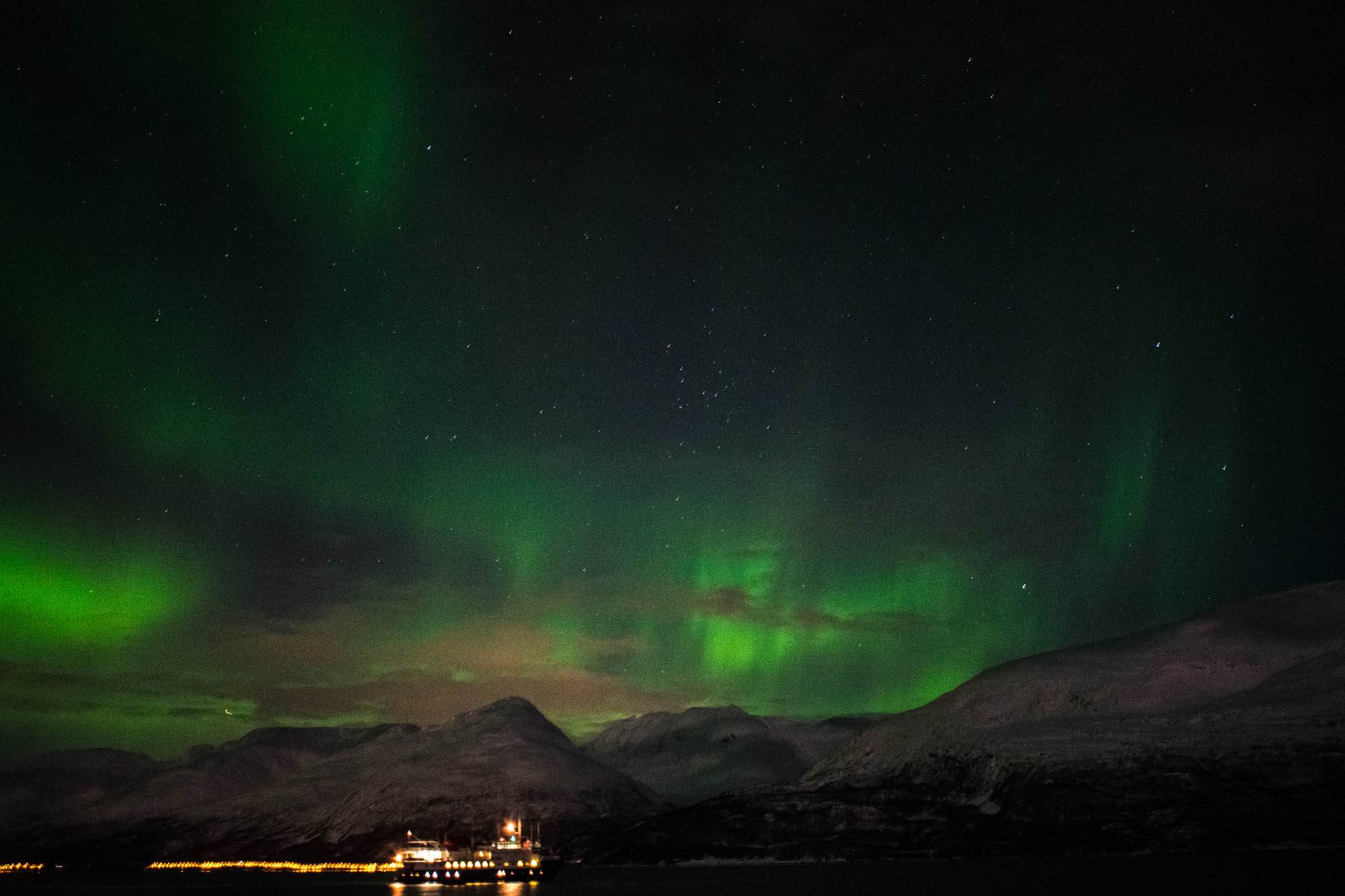
Exciting Expeditions on land
Experiencing the local nature and wildlife played a vital role on the tour, this included the culture and history of Northern Norway. Through interesting lectures on the boat, visits to little fishing villages, and through chats with local producers we got a thorough glimpse at life north of the Polar Circle.
Havnnes – The Northernmost preserved trading post in Norway
One such visit was to Havnnes, which is a small village known for being the Northernmost preserved trading post in Norway. The village is still in use today.
As our ship docked near Havnnes harbour, the little dinghys were once again ready at hand to bring us safely onto the mainland. We were all given thermal suits and life jackets to ensure a safe passage. Once on the mainland, there were plenty of activities to choose from.
In Havnnes, you can learn more about the coastal culture and lifestyle of Northern Norway, experience an exhibition on Sami life and culture, and even pick up a few necessities from the local store. Havnnes is a listed 19th century trading post, and the local store is the lifeblood of the area: this is where the locals can send and receive parcels, perform bank transactions, and pick up some fresh bread for their Saturday breakfast. Havnnes has around 50 inhabitants during the winter months, and the number increases slightly over the summer months.
We had plenty of fun discovering one of Havnnes most famous peculiarities – the way the old coastal houses had originally been painted. As traditional white paint was very expensive, the local fishermen often only painted the sides of their houses that could be seen from the harbour, as this is where visitors would arrive. A cheap red paint would be used on the remaining walls. As most of the houses in Havnnes have been listed, you can have a walk around and see it for yourself.
Furthermore, these houses are some of the few that remain in this part of Northern Norway after World War 2. The areas of Troms and Finnmark were badly hit during the German evacuation of 1944, when most of the buildings were burnt down. The Germans, however, wanted to save the buildings of Havnnes because they though they had artistic value. This means that Havnnes is one of the few authentic fishing villages that remains in this part of the country.
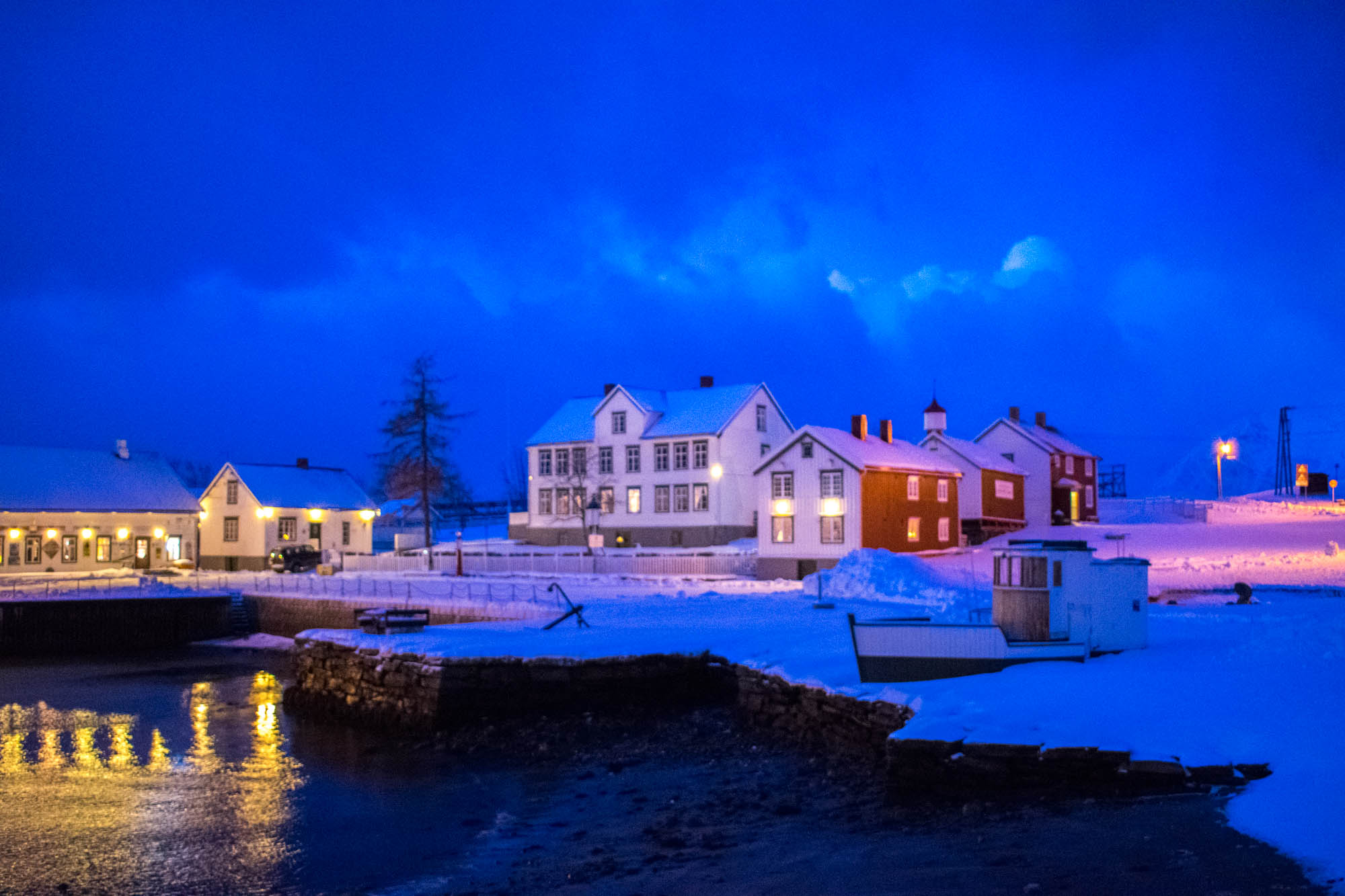
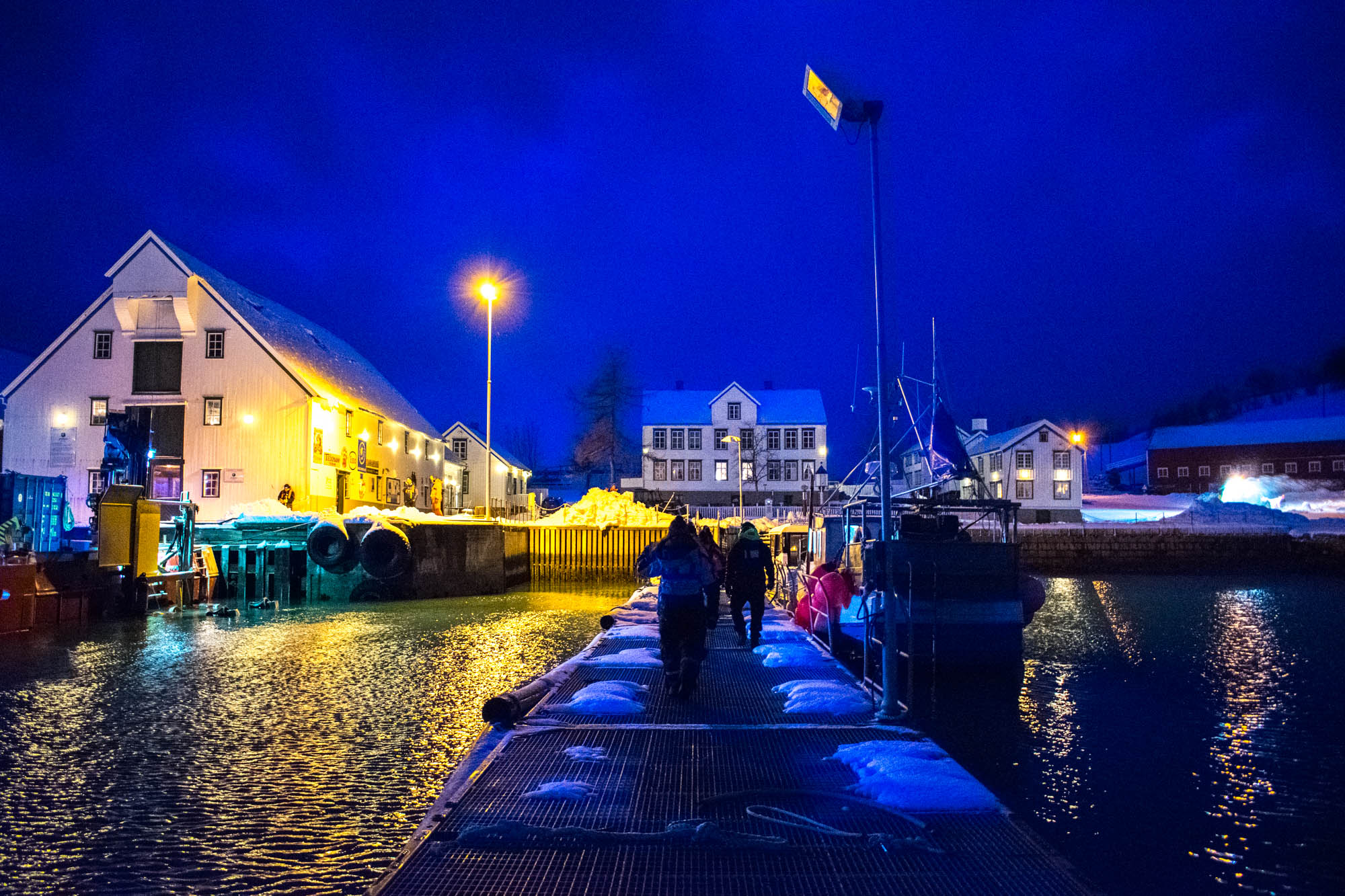
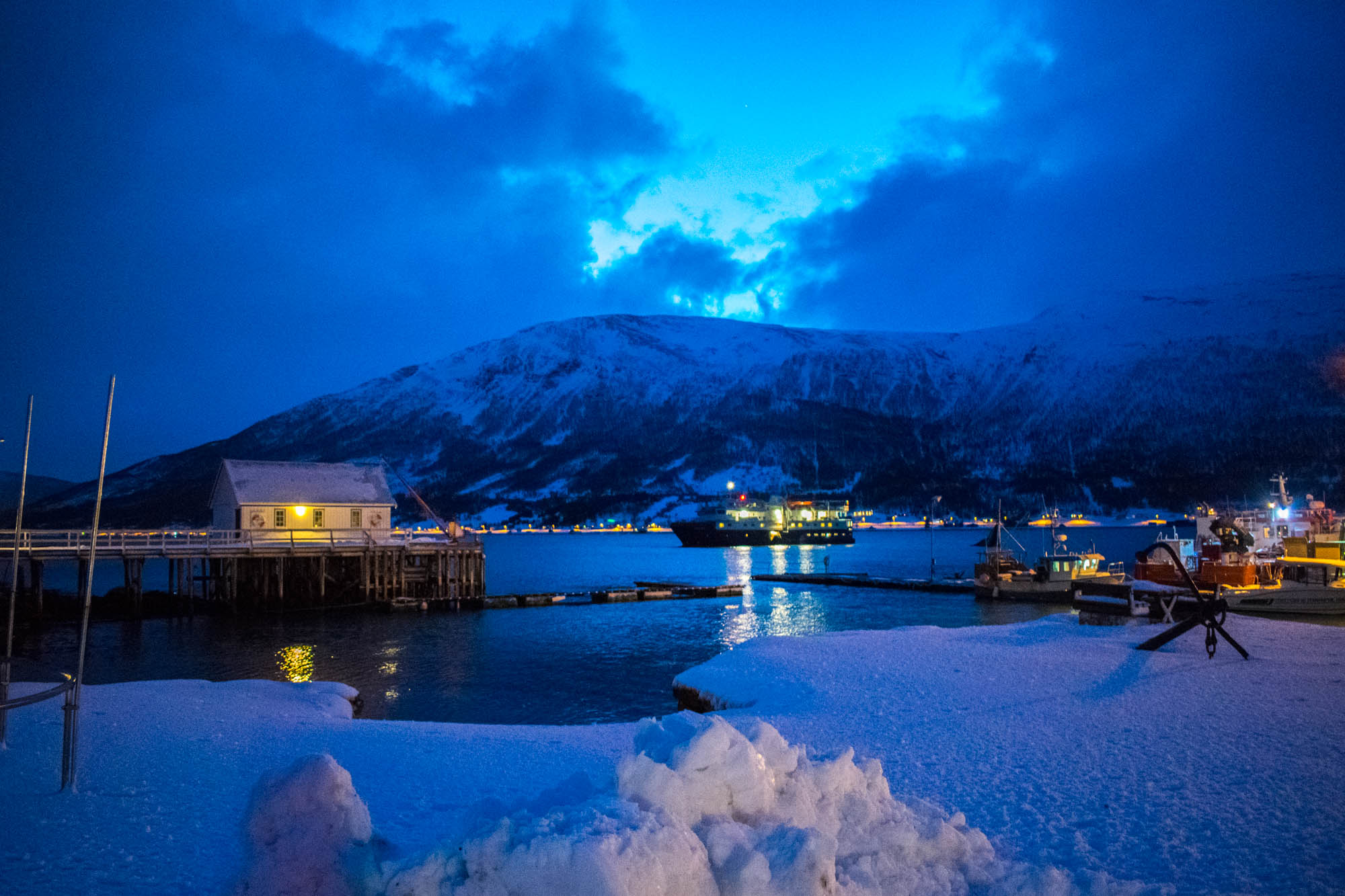
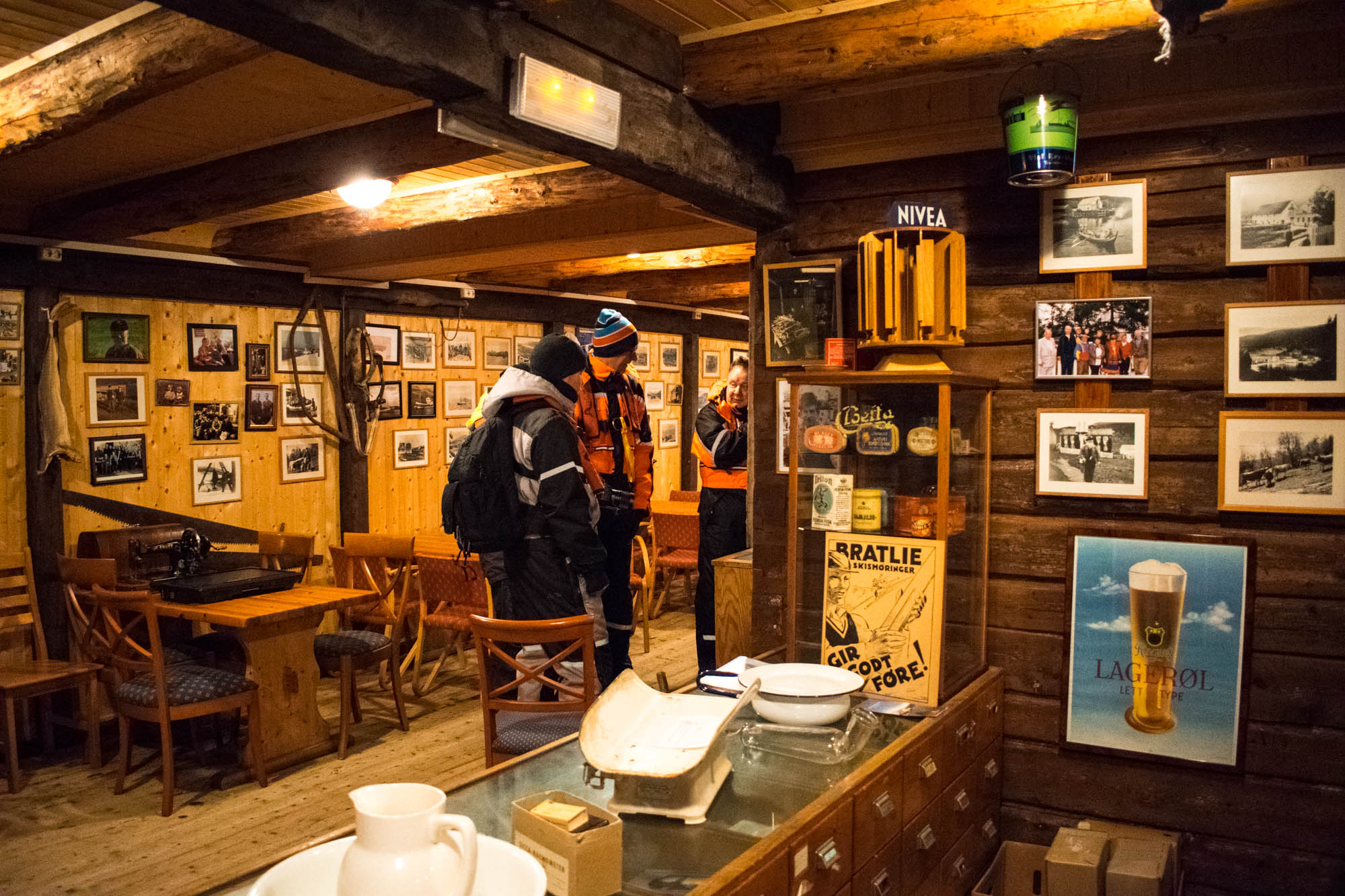
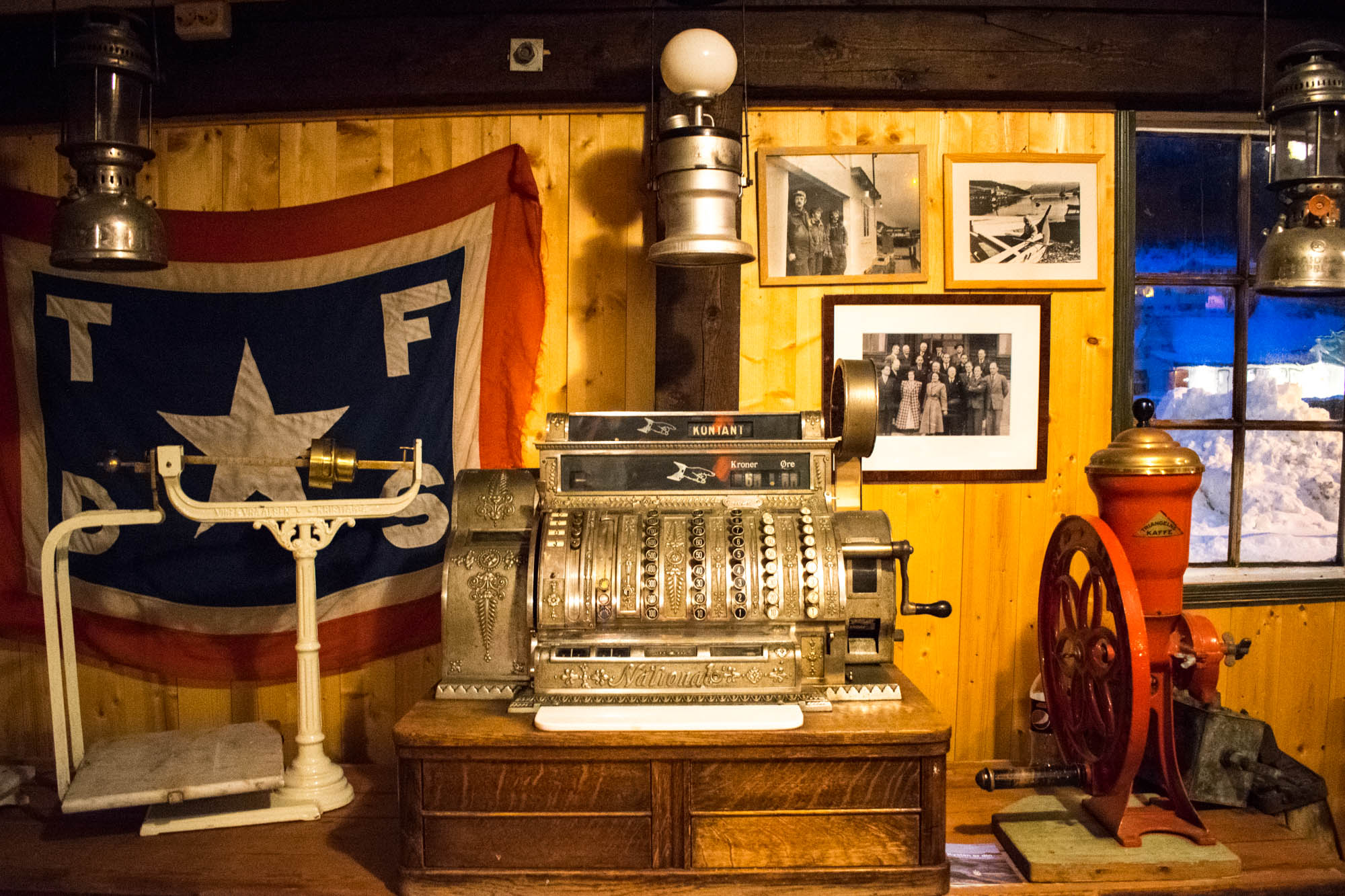
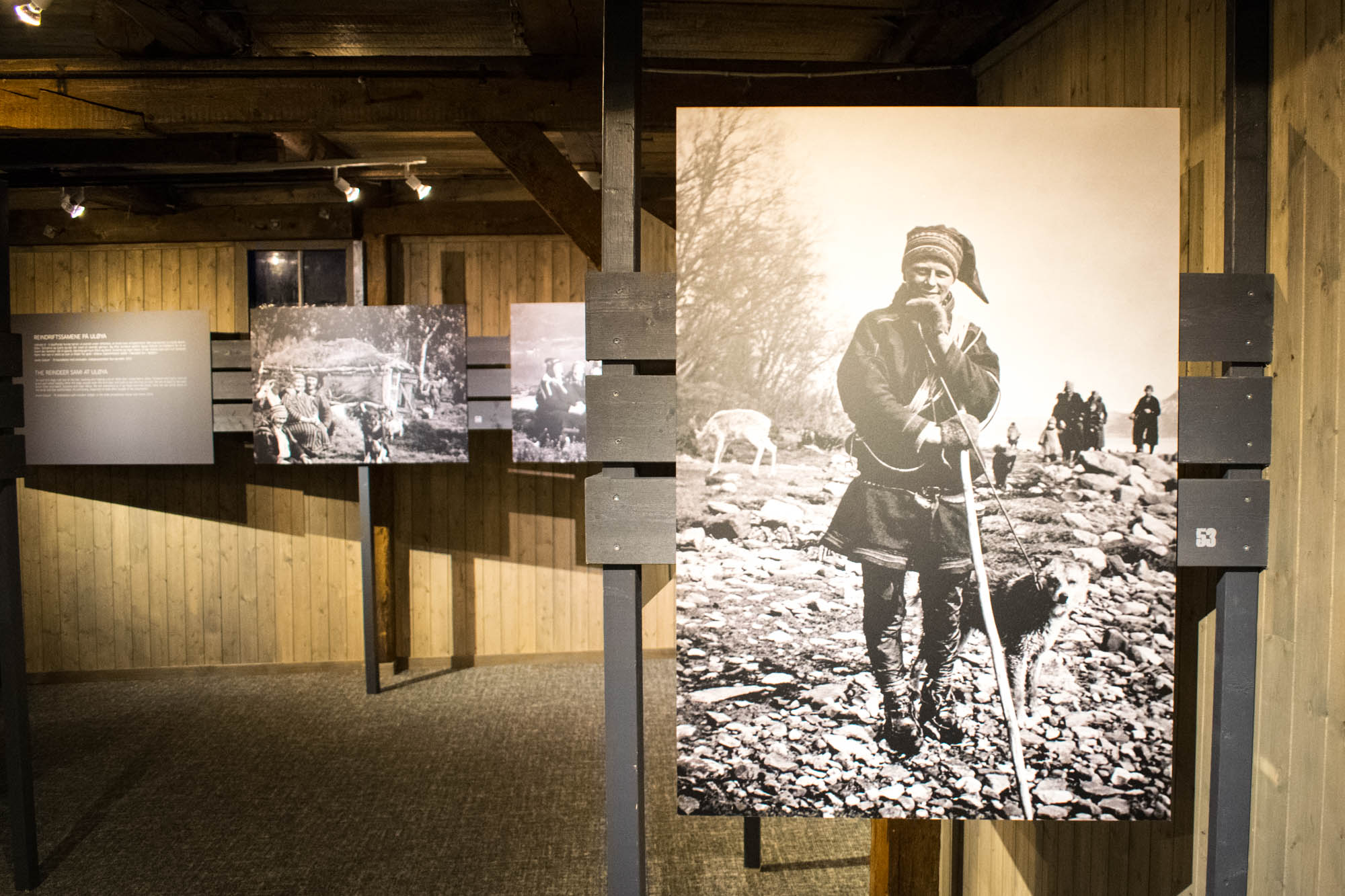
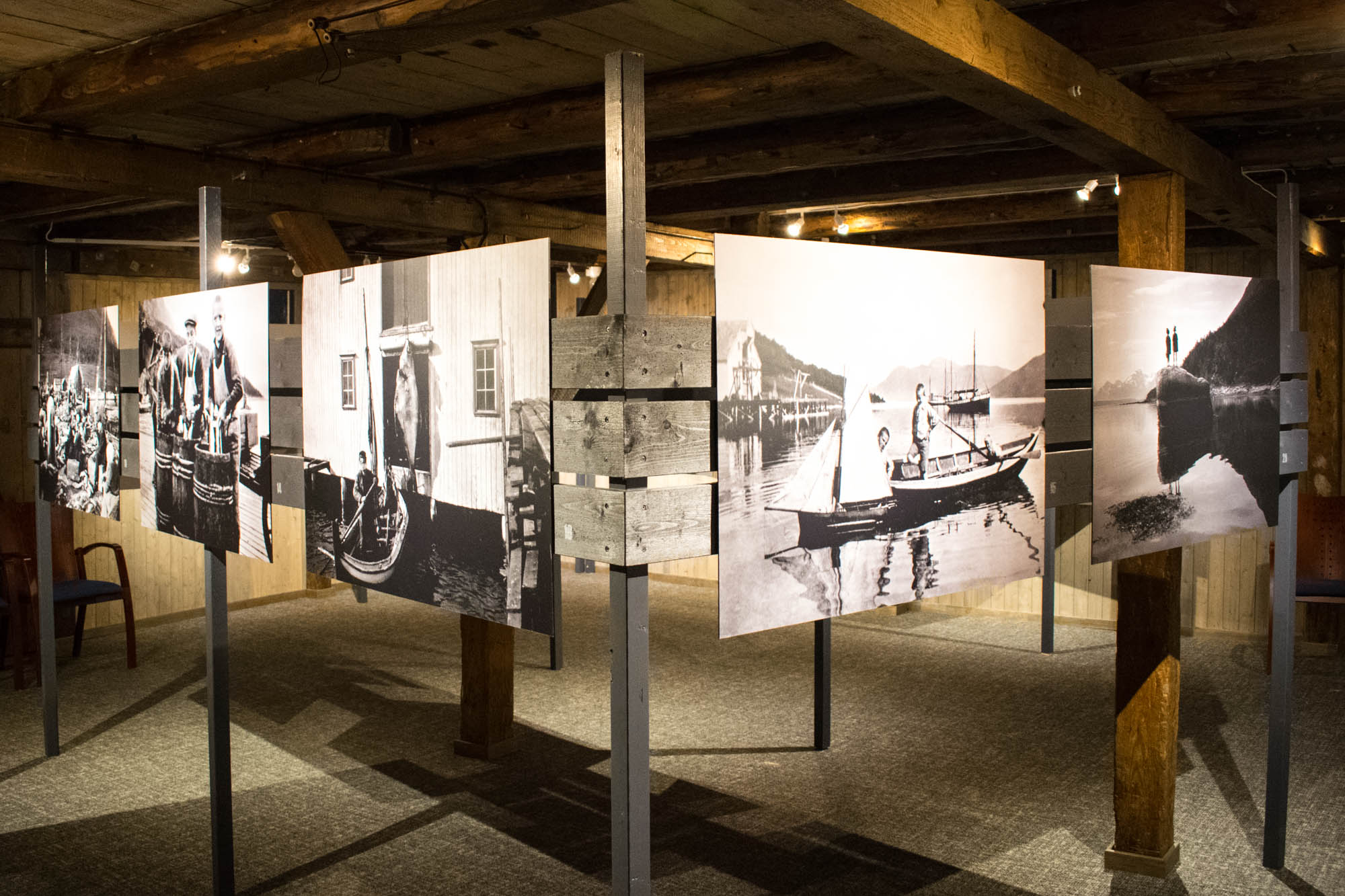
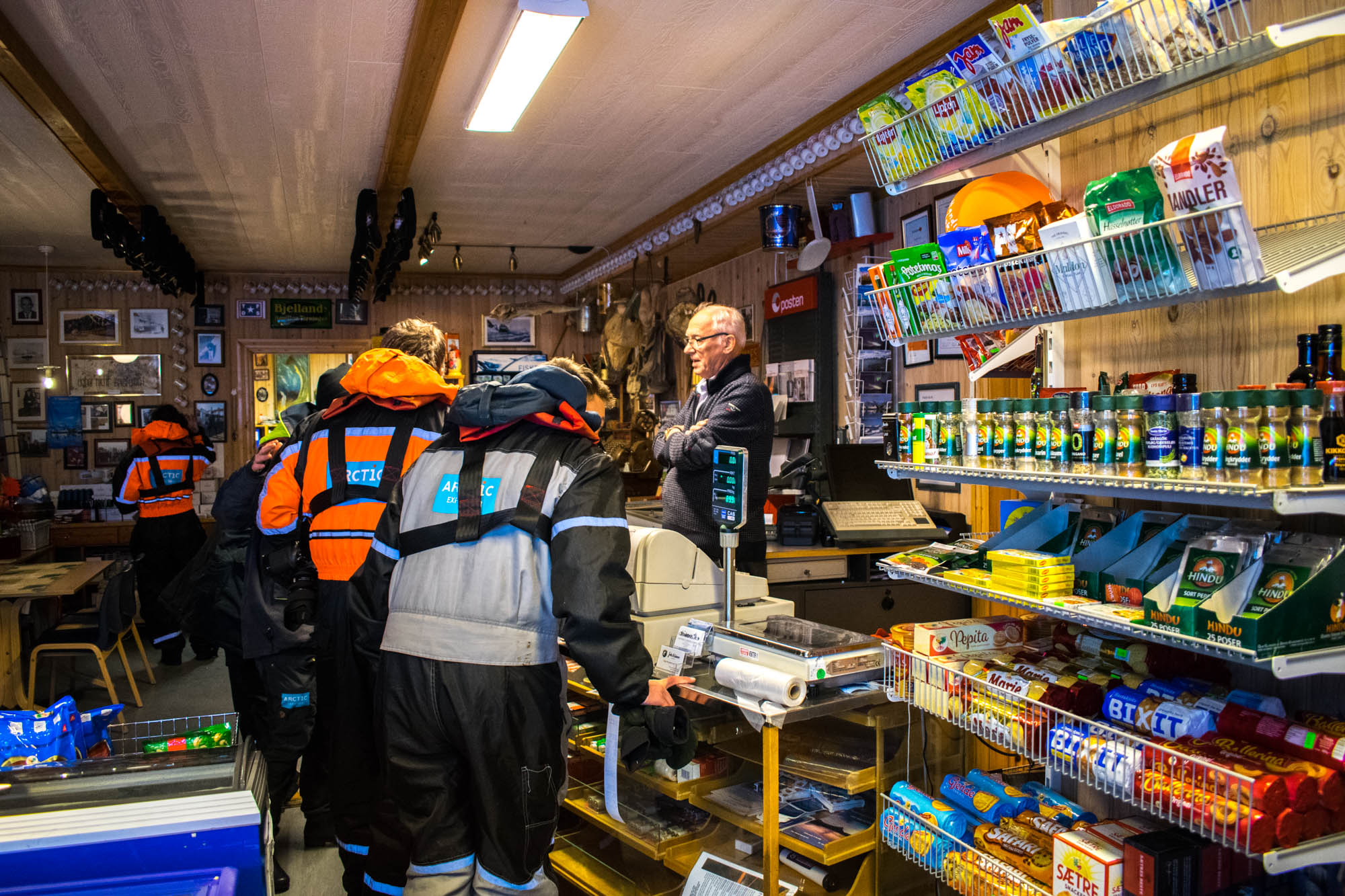

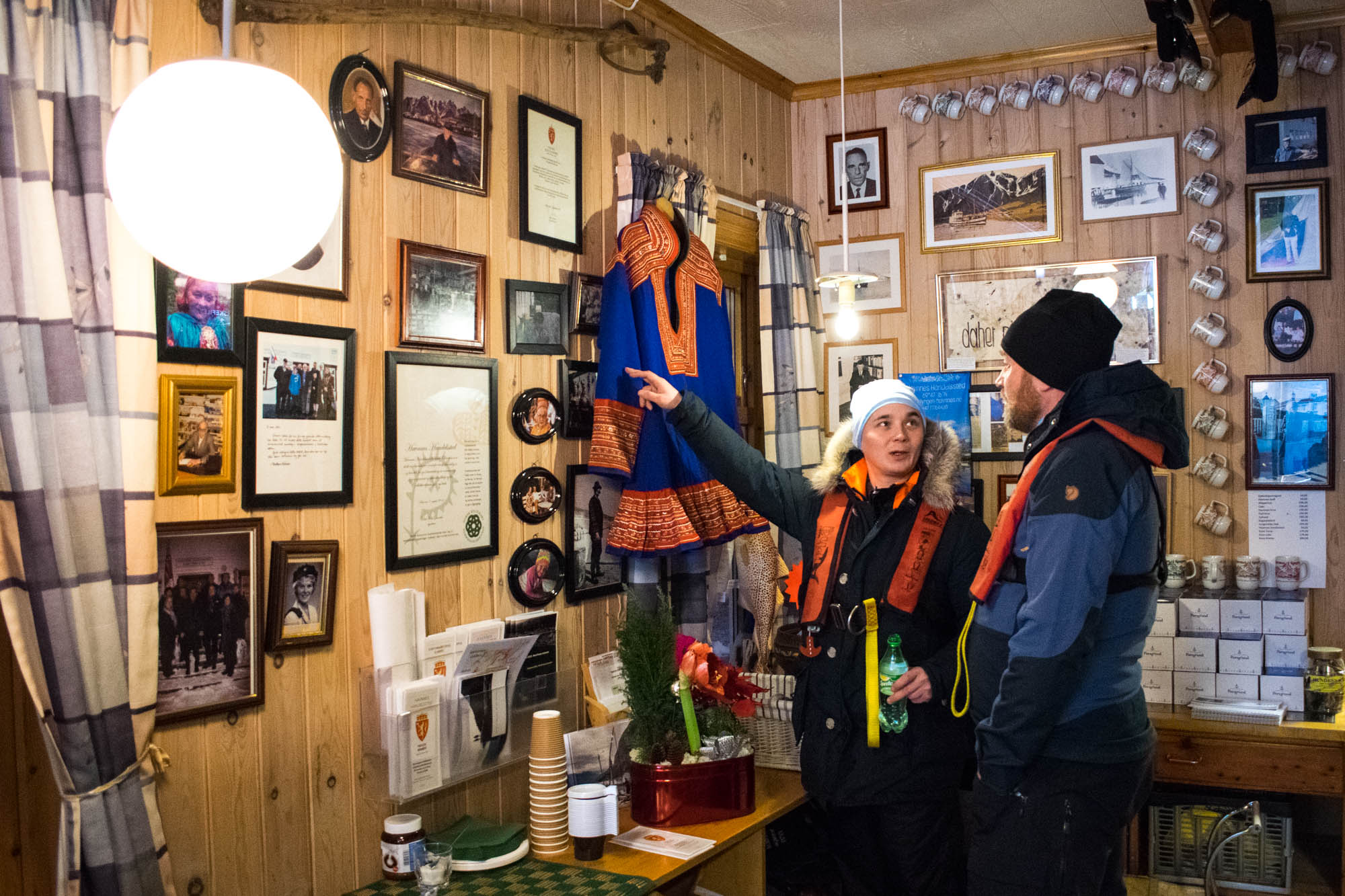
Visiting Aurora Spirit – The Northernmost distillery in the world
Entrepreneurial spirit and creativity blooms even in the Arctic landscape.
During my trip, I made a visit to Aurora Spirit, which is the northernmost distillery in the world. The distillery is located in Årøybukneset, in a former NATO bunker that was left behind after the end of the Cold War. They have recently expanded, and there’s now a modern visitor center built on top of the bunker. The building itself is seated on the crest of a small hill, and the panoramic windows provides a stunning view of the famous Lyngenalpene. I think it’s hard to find a more dramatic backdrop than this.
Aurora Spirit produces vodka, aquavit, gin and whisky under the name Bivrost, which is the old viking name for the Northern Lights. Although the distillery opened in 2016, they have managed to launch themselves as an important producer in the world of spirits. Their products are of high quality, and they grow more popular each and every year. During our visit, we were lucky enough to be given a full tour in both the storage and production facilities – and we even got to try a few drops of the produce!
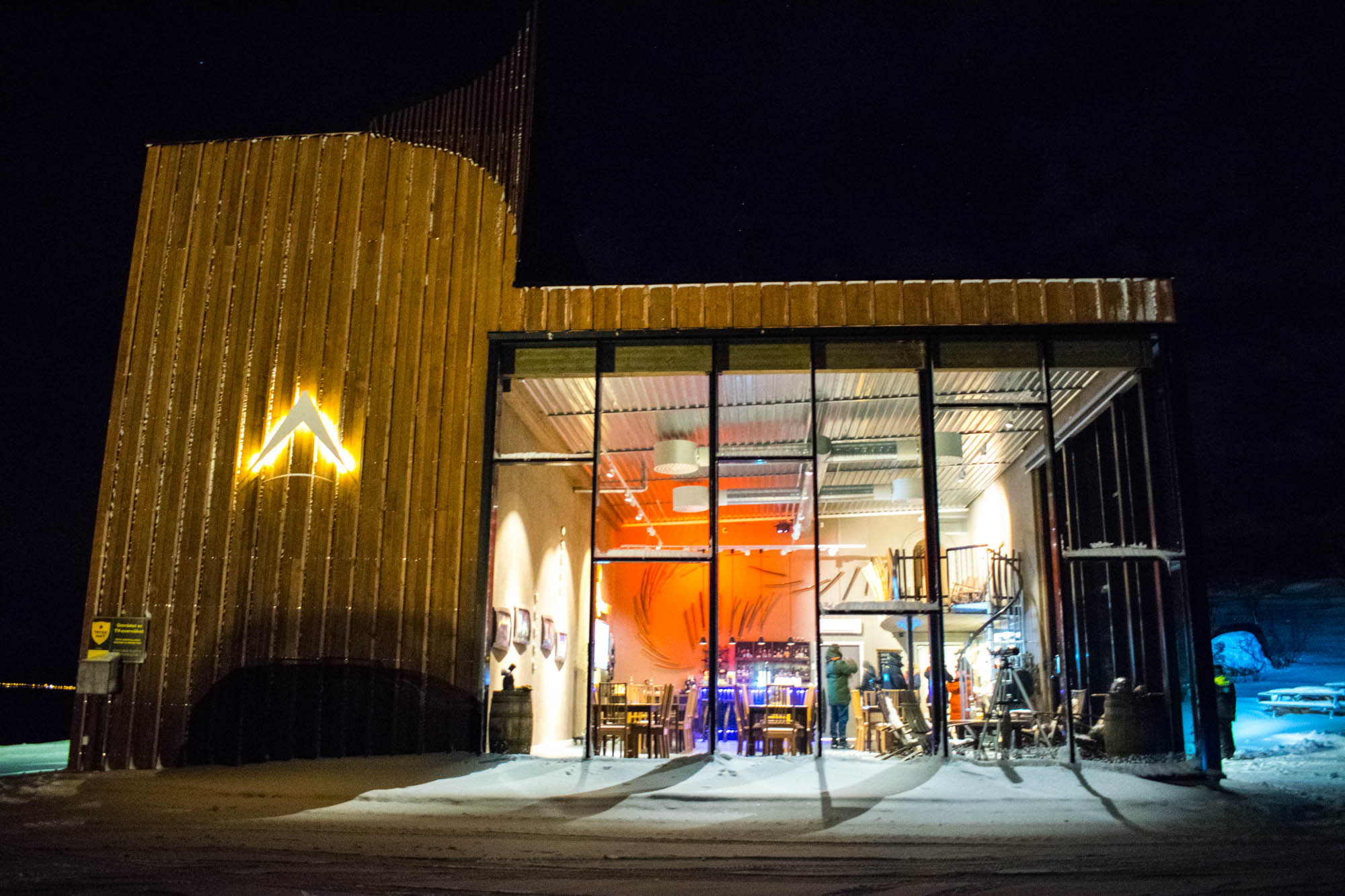
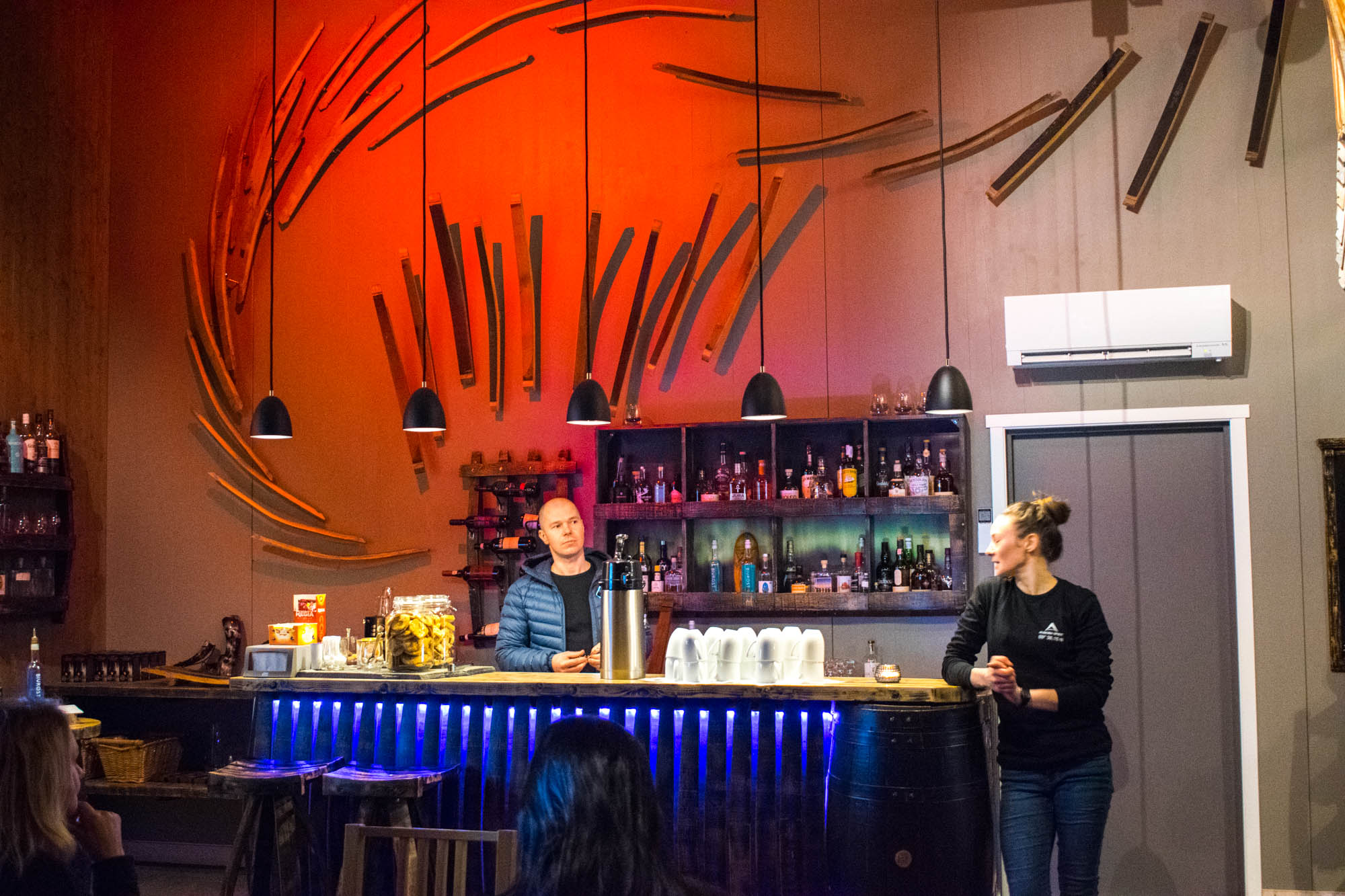
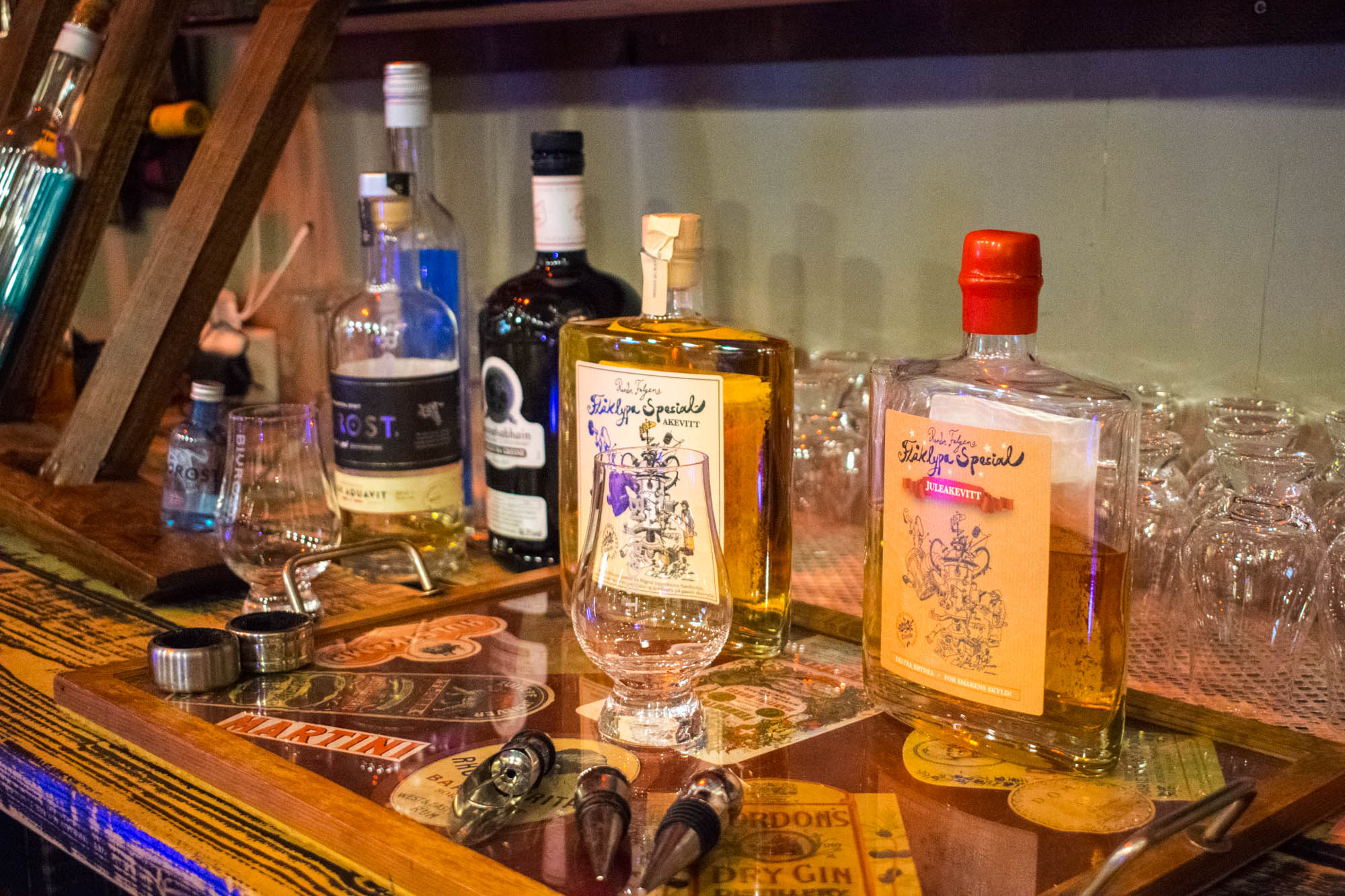
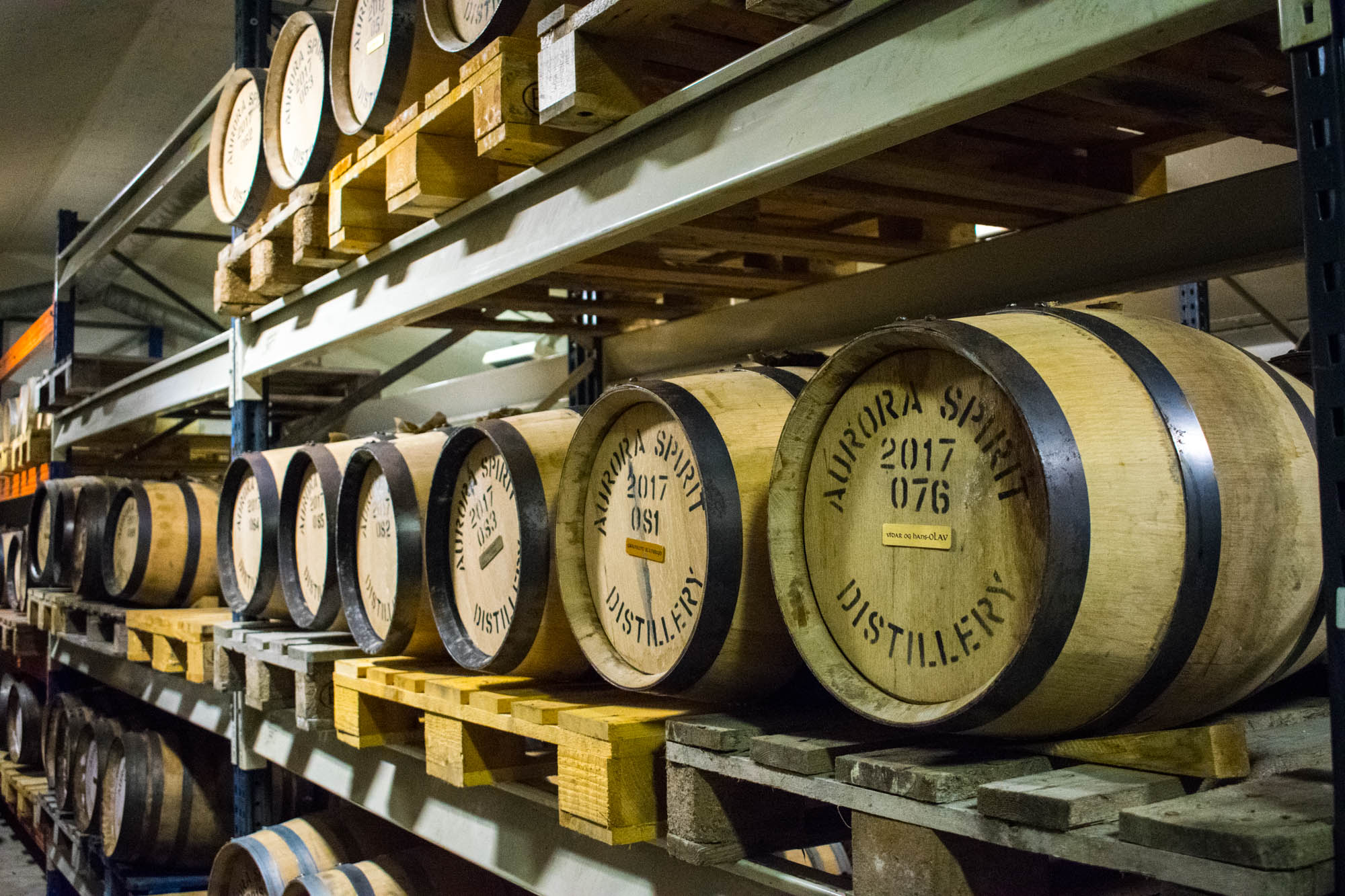
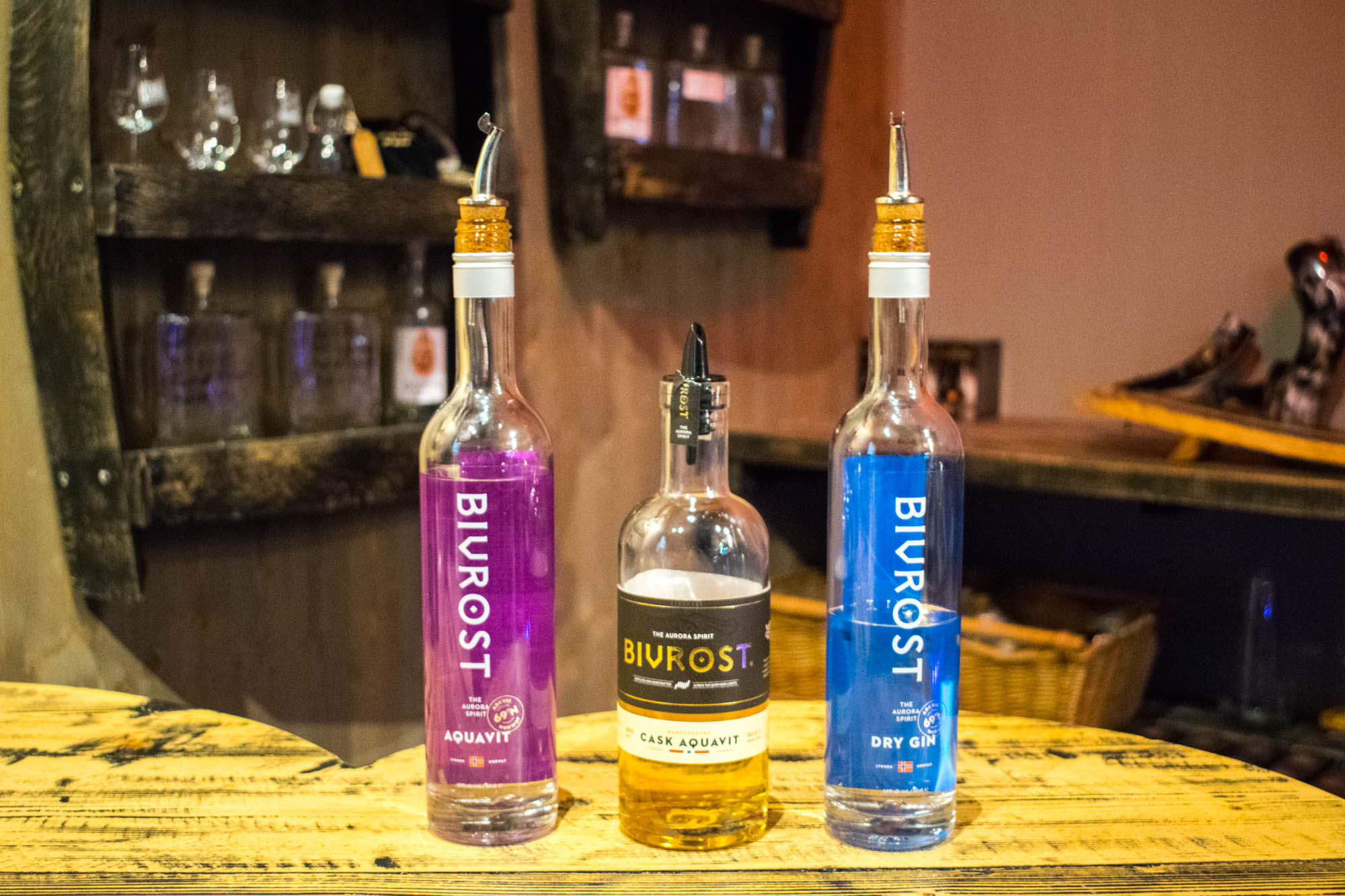
Experiencing Local and Traditional Food
When you’re on an adventure, food naturally plays an important role!
We had all our meals together in the restaurant onboard Quest, and I was thrilled to find that the various dishes were based on local products and traditions. While breakfast and lunch were a buffet consisting of both hot and cold dishes, the dinner was a 3-course meal. And what an incredible experience that was!
For dinner, you could choose between vegetarian, fish or meat for your starter and main, and there were also plenty of desserts to choose from. If, for whatever reason, the set meals didn’t appeal to you, they also offered more well-known international dishes. No one left the table hungry! Our ship also had a bar, the Panorama Lounge, where we could buy hot drinks during the day, and beer and wine during the evenings. This ended up being a natural place to gather and socialize in our spare time.
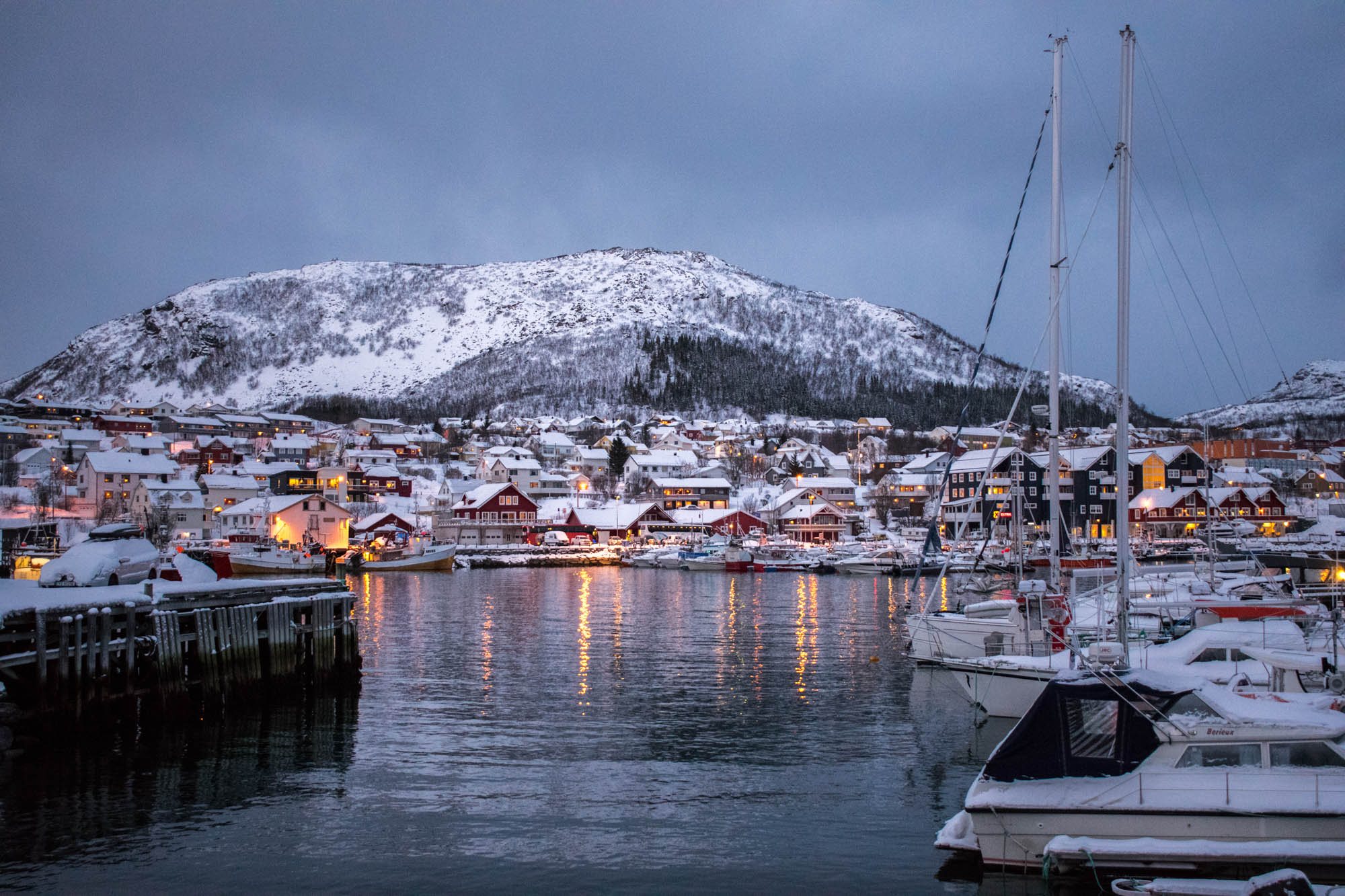
Book Your Tour with Arctic Expedition
Do you fancy experiencing the Arctic wildlife and culture for yourself? Arctic Expedition offers exciting expeditions and tours of the Arctic – both during summer and winter.
If a long expedition sounds like a little too much for you, they also offer several day trips, such as snow mobile trips or dog sledding. All the day tours are available from Tromsø, Porsanger, Alta, Lofoten or Svalbard. Find the complete list of their Arctic winter experiences, and book your next Arctic adventure here.
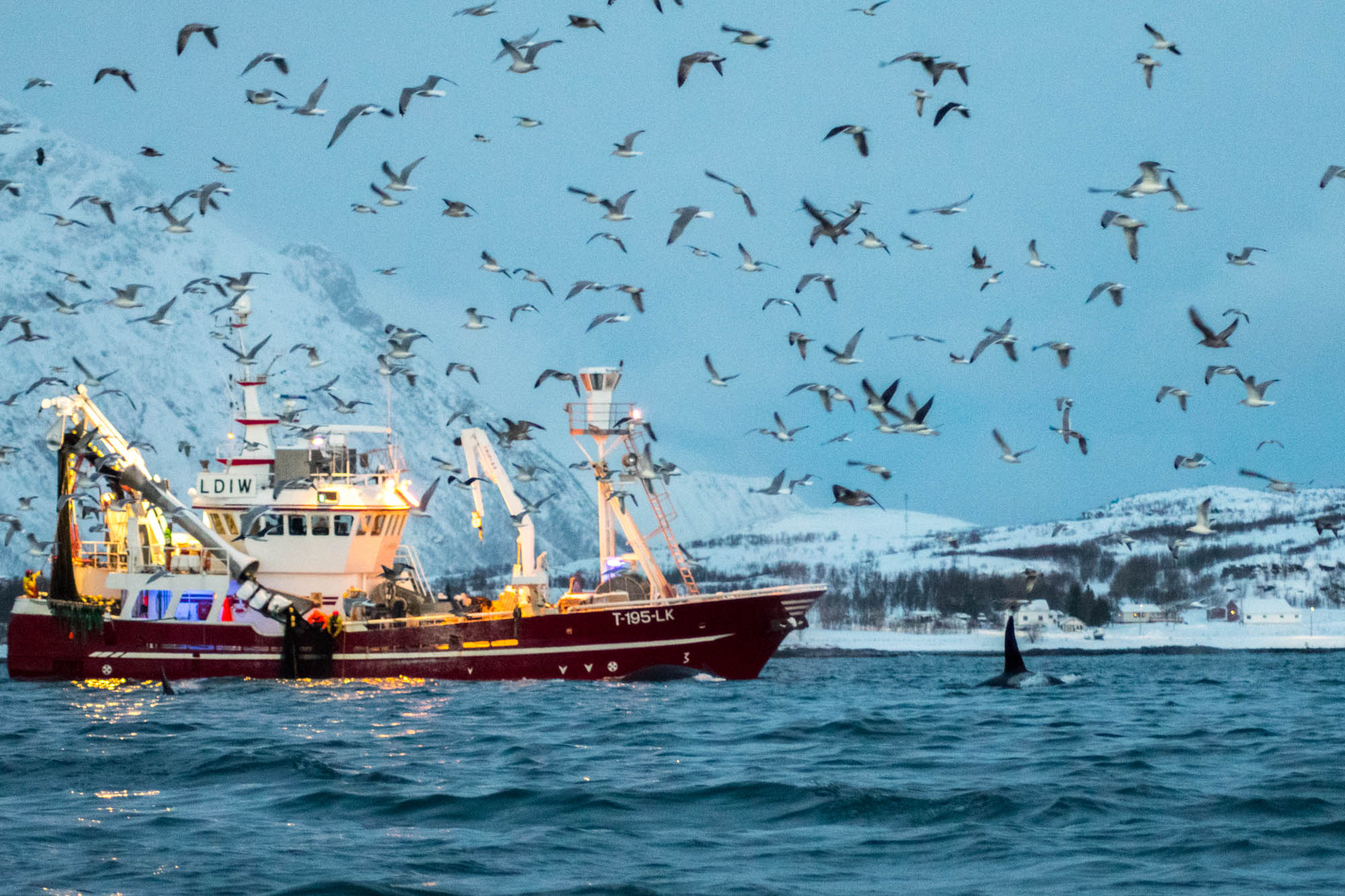
Disclaimer: I was invited on this trip in order to market the exciting tours that are offered by Arctic Expedition. However, I always give my honest opinion on any trips or products featured here.
This post is also available in: Norsk bokmål


